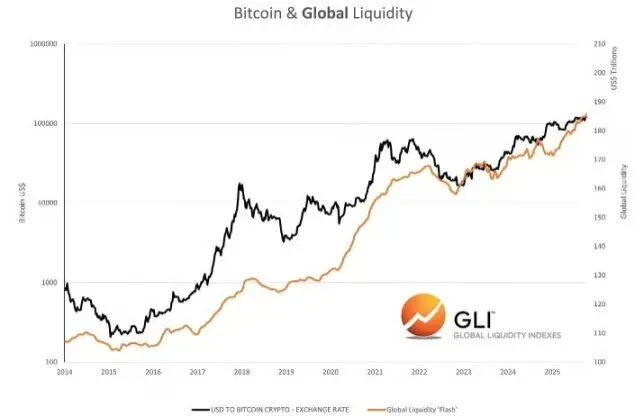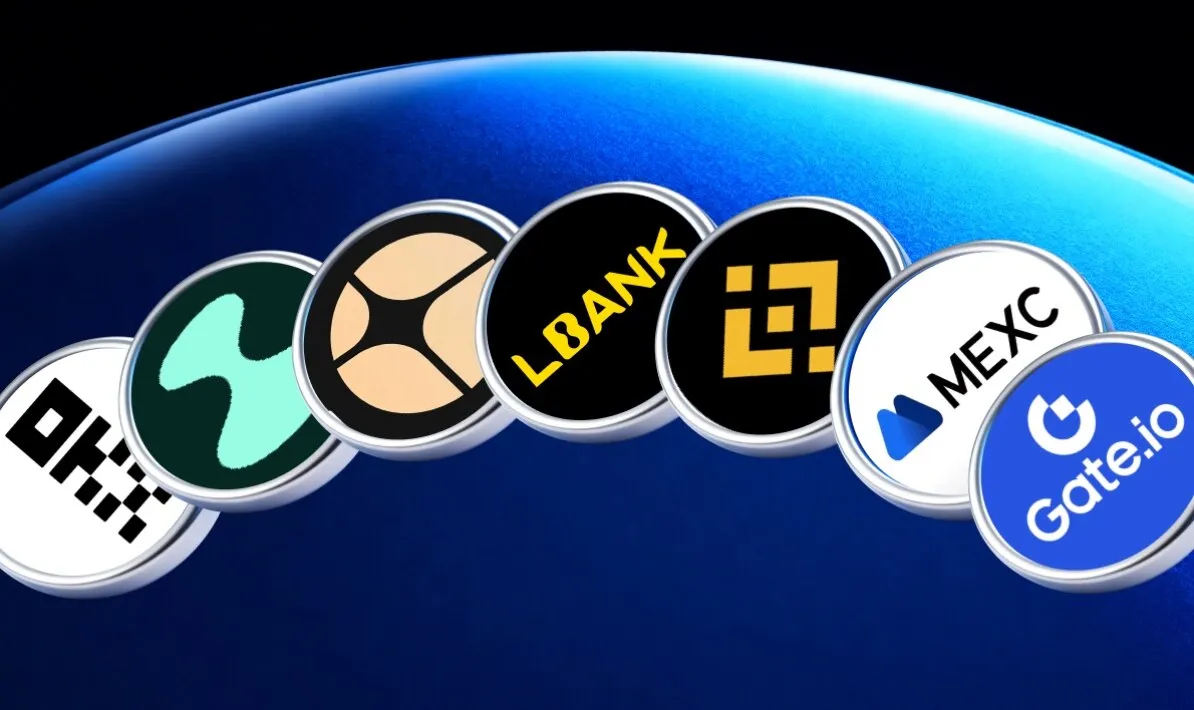This article is from: a16z crypto
Translation|Odaily Planet Daily (@OdailyChina); Translator|Azuma (@azumaeth)_
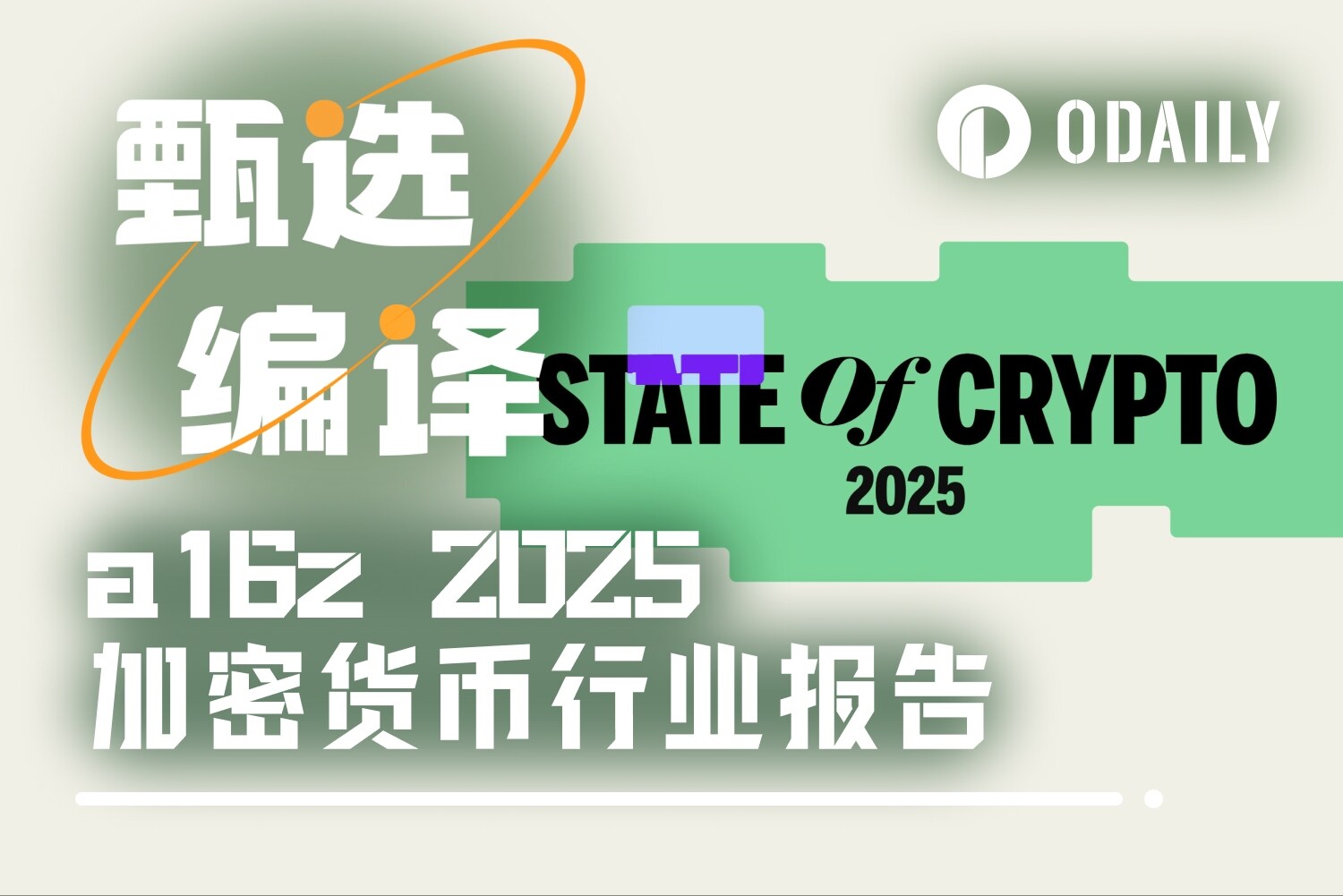
A Year of Going On-Chain
When we released the first edition of the “State of Crypto” report in 2022, the industry was still in its adolescence. At that time, the total value of the crypto market was less than half of what it is today. The speed of blockchain was slower, costs were higher, and reliability was poorer.
Over the past three years, builders in the cryptocurrency industry have faced severe market corrections and political uncertainties, yet they have continued to improve infrastructure and drive technological advancements. It is these efforts that have brought us to today—a moment when the cryptocurrency industry is gradually becoming an important part of the modern economy.
The crypto story of 2025 is a story of industry maturity.
In short, cryptocurrency has “grown up”:
- Traditional financial giants like Visa, BlackRock, Fidelity, JPMorgan Chase, and tech-native challengers like PayPal, Stripe, and Robinhood are all offering or launching cryptocurrency products.
- The processing speed of blockchain now exceeds 3,400 transactions per second (an increase of over 100 times compared to five years ago).
- Stablecoins support an annual transaction volume of $46 trillion (adjusted to $9 trillion), comparable in scale to Visa and PayPal.
- The total assets of Bitcoin and Ethereum ETF products have exceeded $175 billion.
In our latest “State of Crypto” report, we delve into this industry transformation: from institutional adoption to the rise of stablecoins, and the integration of cryptocurrency with artificial intelligence. Additionally, this year we introduced a brand new way to explore data—the State of Crypto Dashboard—allowing readers to track industry evolution in real-time using key metrics.
Here are our main findings.
Key Points
- A large, global market that continues to grow;
- Financial institutions fully embracing cryptocurrency;
- Stablecoins going mainstream;
- The influence of cryptocurrency in the U.S. is unprecedented;
- The world is moving on-chain;
- Blockchain infrastructure is (almost) ready for prime time;
- Cryptocurrency and artificial intelligence are merging.
A Large, Global Market That Continues to Grow
In 2025, the total market capitalization of cryptocurrency surpassed $4 trillion for the first time, marking an important milestone in the overall development of the industry. Meanwhile, the number of mobile wallet users reached an all-time high, growing by 20% compared to last year.
From a previously harsh regulatory environment to a more supportive policy atmosphere today; coupled with the tokenization of stablecoins and traditional financial assets, as well as the accelerated adoption of other emerging applications—these will become the core driving forces of the next cycle.
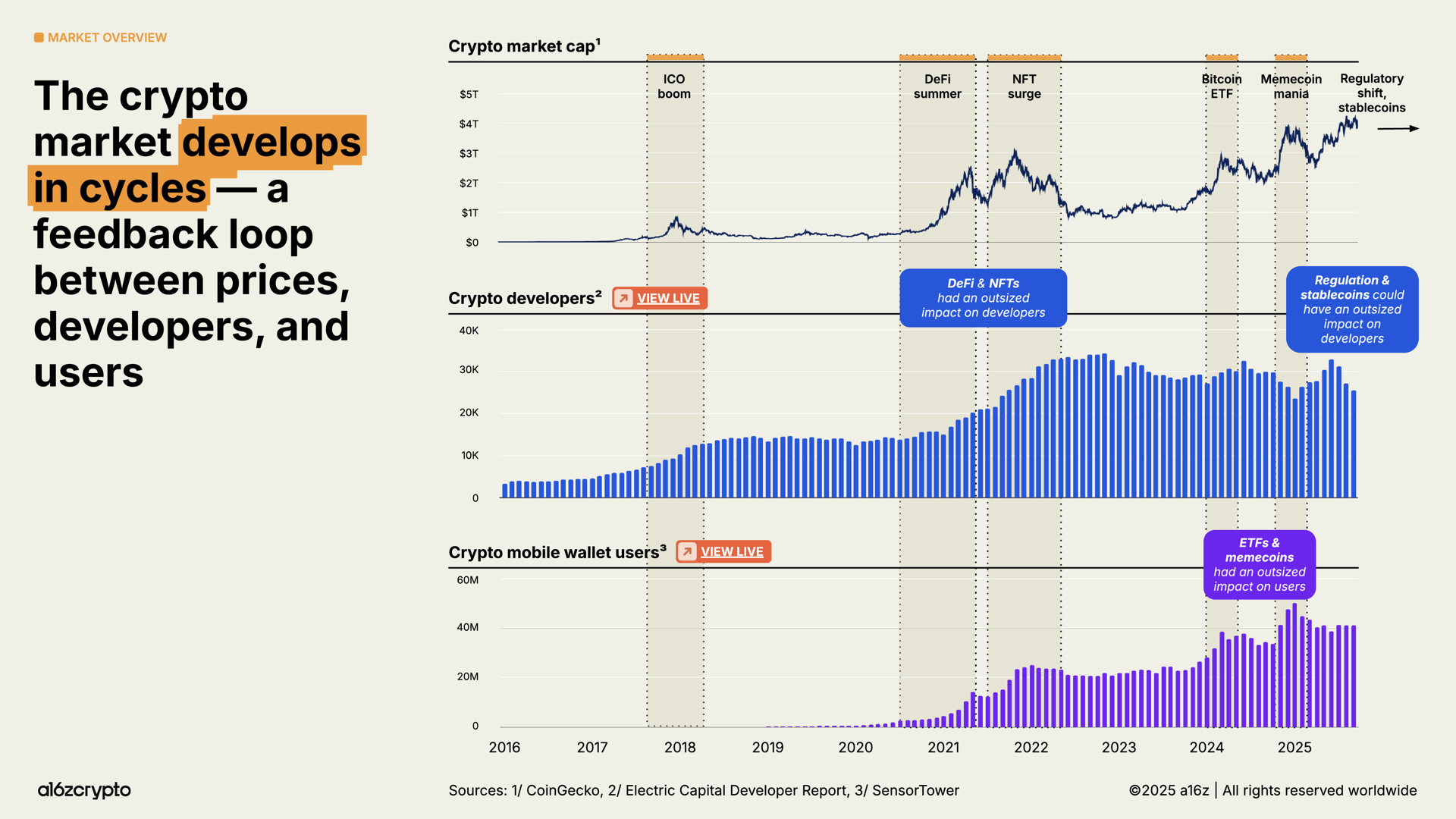
According to our updated analysis based on this methodology, there are currently approximately 40 million to 70 million active cryptocurrency users, an increase of about 10 million from last year. This only represents a small portion of the estimated 716 million people who hold cryptocurrency, which has grown by 16% from last year; it also represents only a small fraction of the approximately 181 million monthly active addresses on-chain, which has decreased by 18% from last year.
This gap indicates a significant potential space between the “holders but inactive” group (those who own crypto assets but do not engage in on-chain interactions) and “active on-chain users” (those who frequently transact on-chain). This means that crypto builders have the opportunity to reach more potential users who already hold assets but have not yet deeply engaged in the on-chain economy.
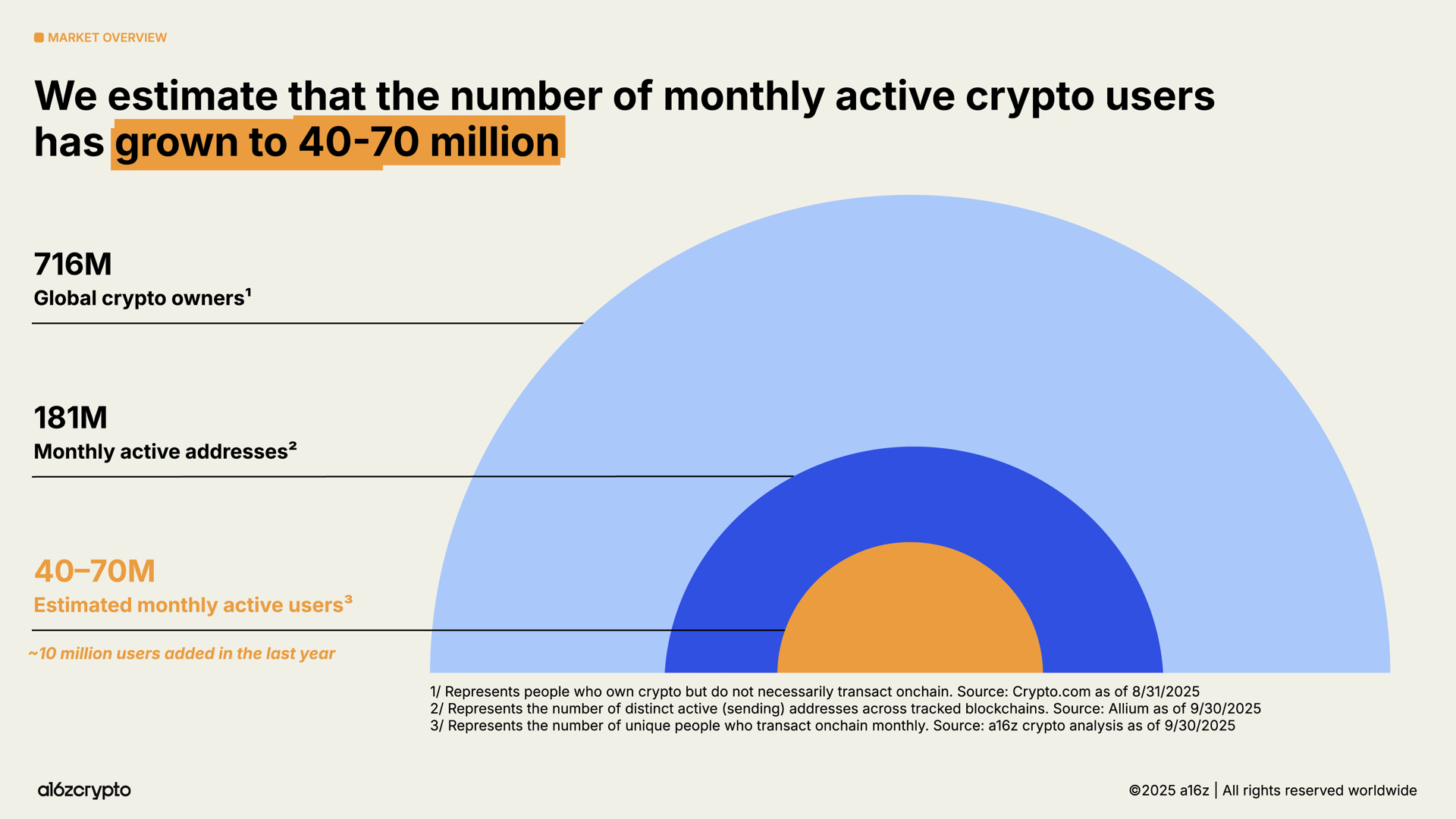
So, where are these cryptocurrency users? What are they doing?
Cryptocurrency is global, but usage varies by region. The use of mobile wallets (an indicator of on-chain activity) is growing fastest in emerging markets like Argentina, Colombia, India, and Nigeria. Particularly amid the escalating currency crisis, the use of cryptocurrency mobile wallets in Argentina has increased 16-fold over the past three years.
Meanwhile, interest in “token” related content is more concentrated in developed countries. Our geographical analysis of traffic sources for token-related web pages shows that activities in these countries (especially Australia and South Korea) may focus more on trading and speculation compared to user behavior in developing countries.
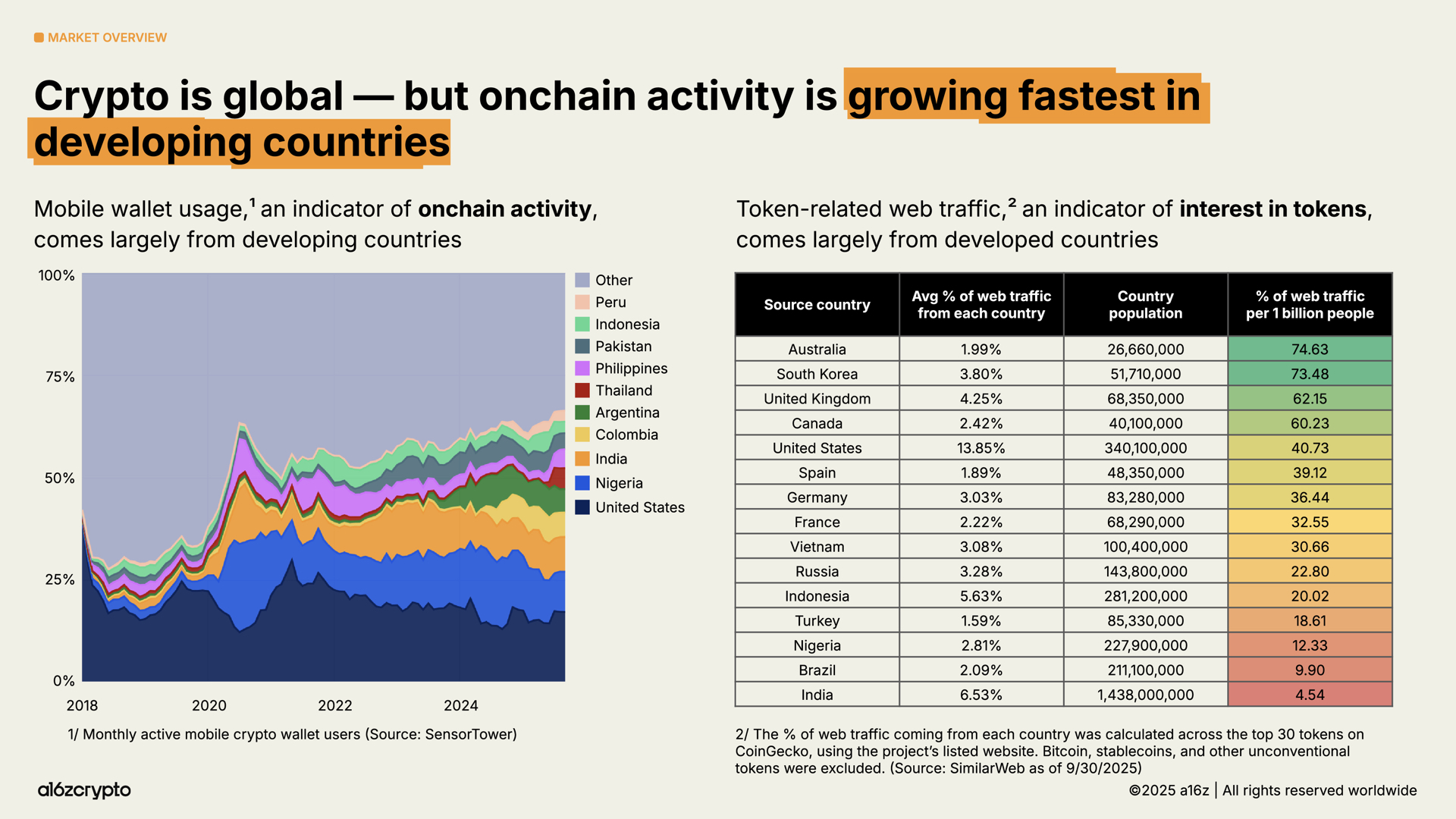
Bitcoin still accounts for more than half of the total market capitalization of cryptocurrency, favored by investors as a store of value, with prices reaching a historic high of over $126,000. Meanwhile, Ethereum and Solana have also recovered most of their declines since 2022.
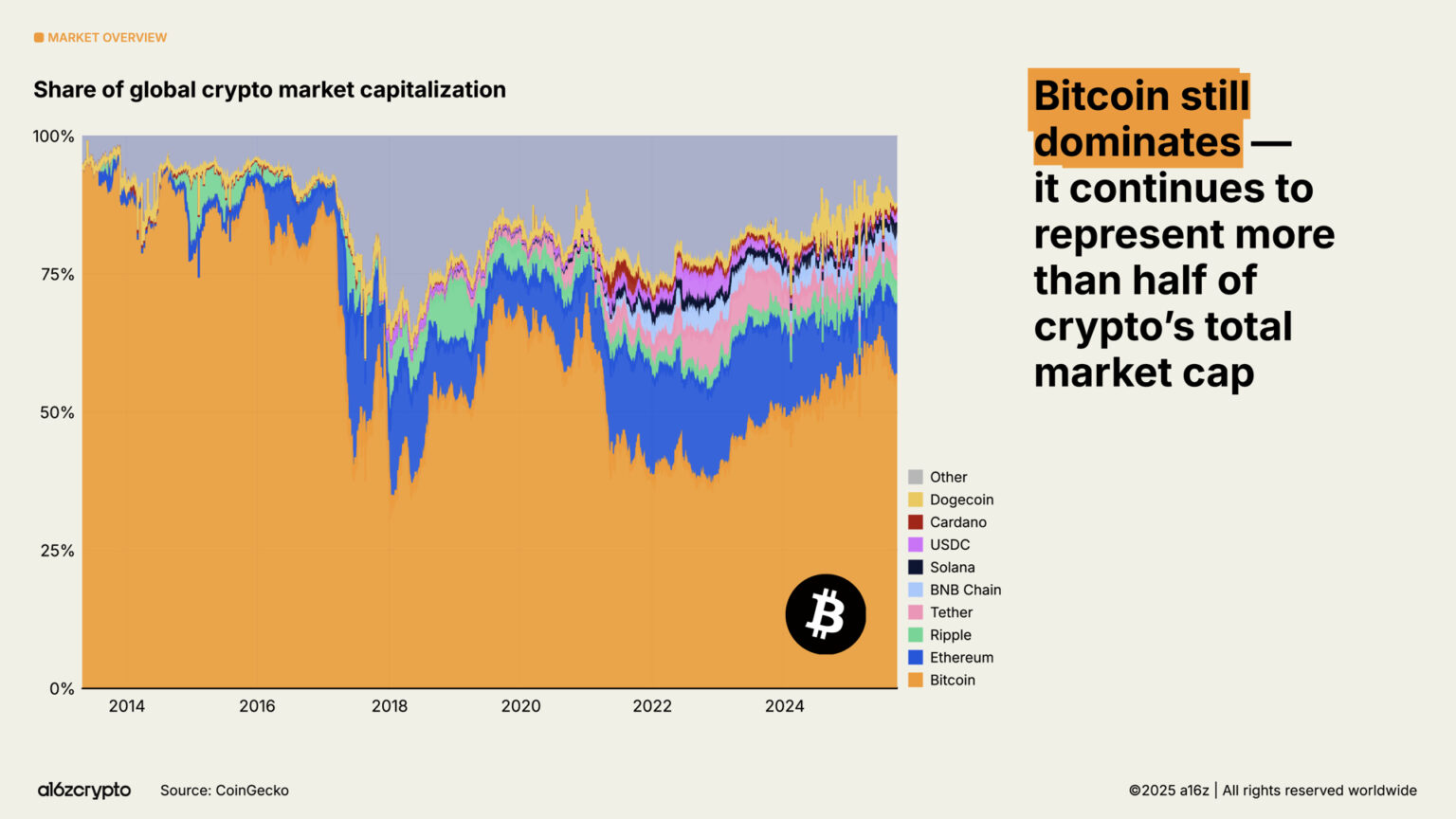
As blockchain continues to expand, the fee market matures, and new applications emerge, certain metrics are becoming increasingly important—one of which is “real economic value”—a measure of how much people actually pay to use the blockchain. Currently, Hyperliquid and Solana account for 53% of the revenue-generating economic activity, marking a significant shift from the previous dominance of Bitcoin and Ethereum.
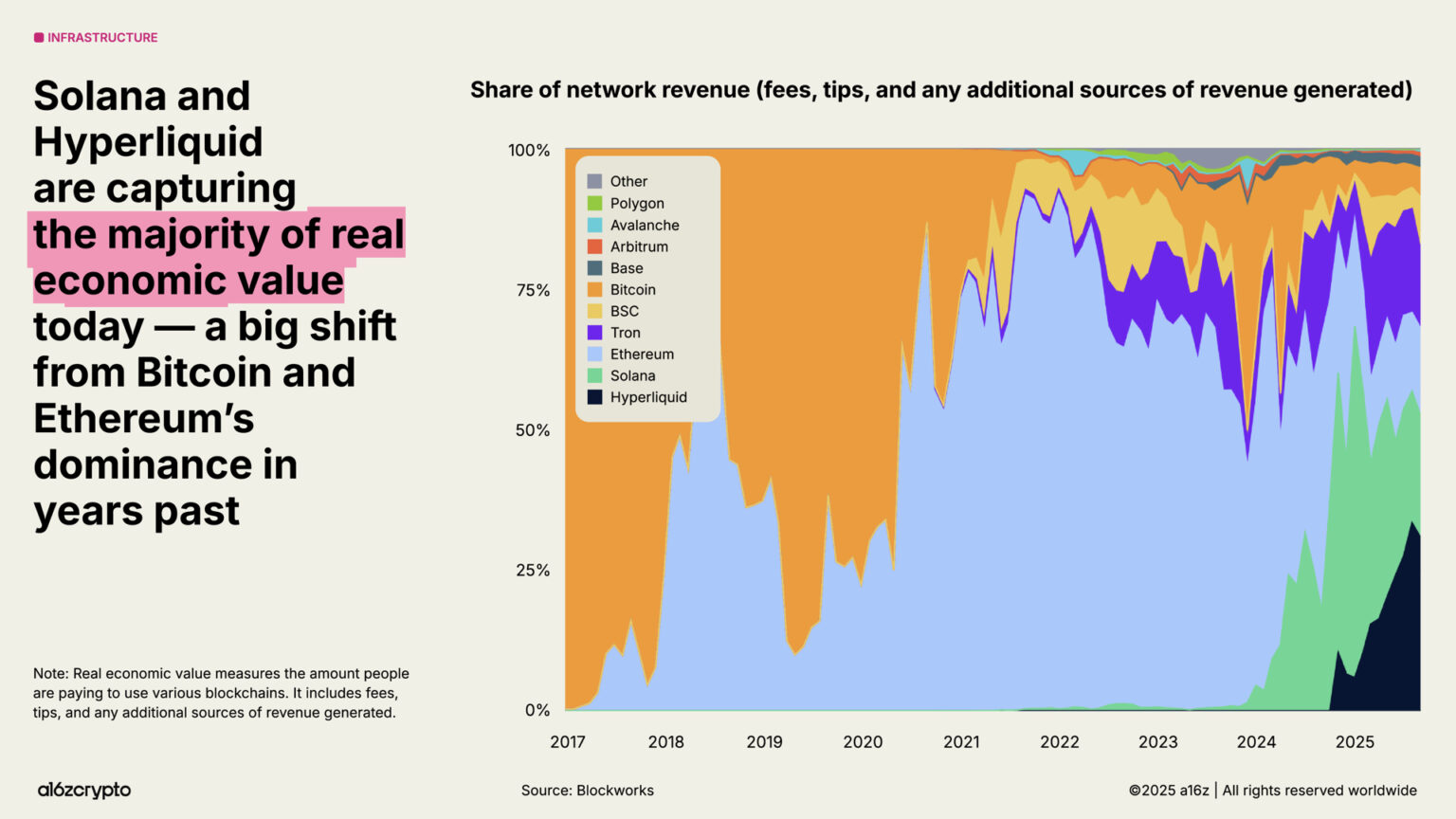
At the builder level, the crypto industry remains multi-chain. Bitcoin, Ethereum (and its L2), and Solana are currently the most attractive ecosystems for developers. By 2025, Ethereum and its layer two networks will be the preferred destination for new developers. Meanwhile, Solana is one of the fastest-growing ecosystems—developer interest has increased by 78% over the past two years.
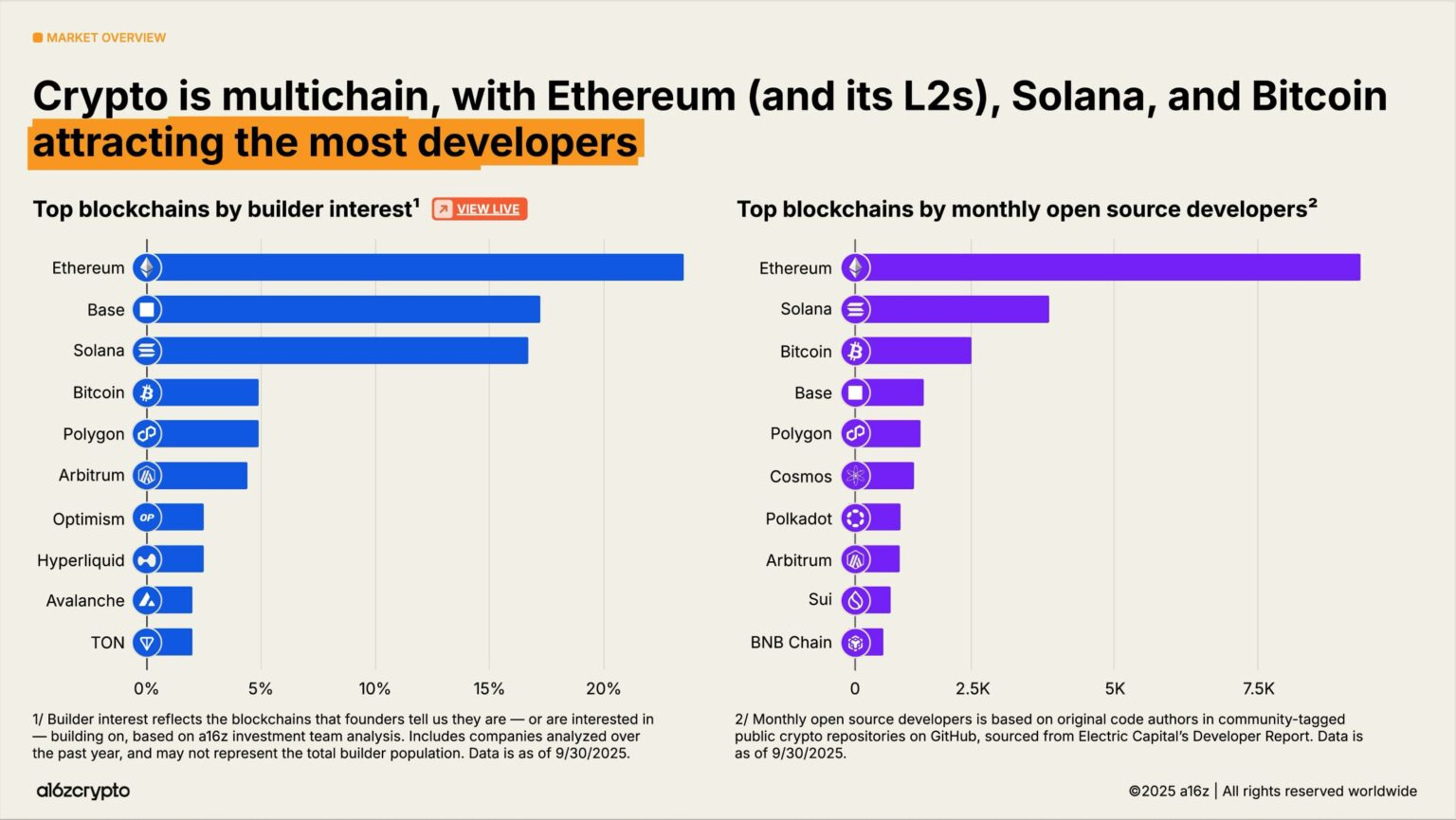
Financial Institutions Fully Embracing Cryptocurrency
2025 is the year of institutional adoption. Just five days after the release of last year's “State of Crypto” report, when we pointed out that “stablecoins have found product-market fit,” Stripe announced plans to acquire the stablecoin infrastructure platform Bridge. Thus, the race officially began—traditional financial institutions are also preparing to publicly enter the stablecoin space.
A few months later, Circle's multi-billion dollar IPO marked the official entry of stablecoin issuers into the ranks of mainstream financial institutions. In July, the U.S. Congress passed the bipartisan “GENIUS” bill, providing builders and institutions with a clear legal framework and regulatory clarity. In the following months, mentions of stablecoins in SEC filings increased by 64%, and major financial institutions followed suit with related announcements.
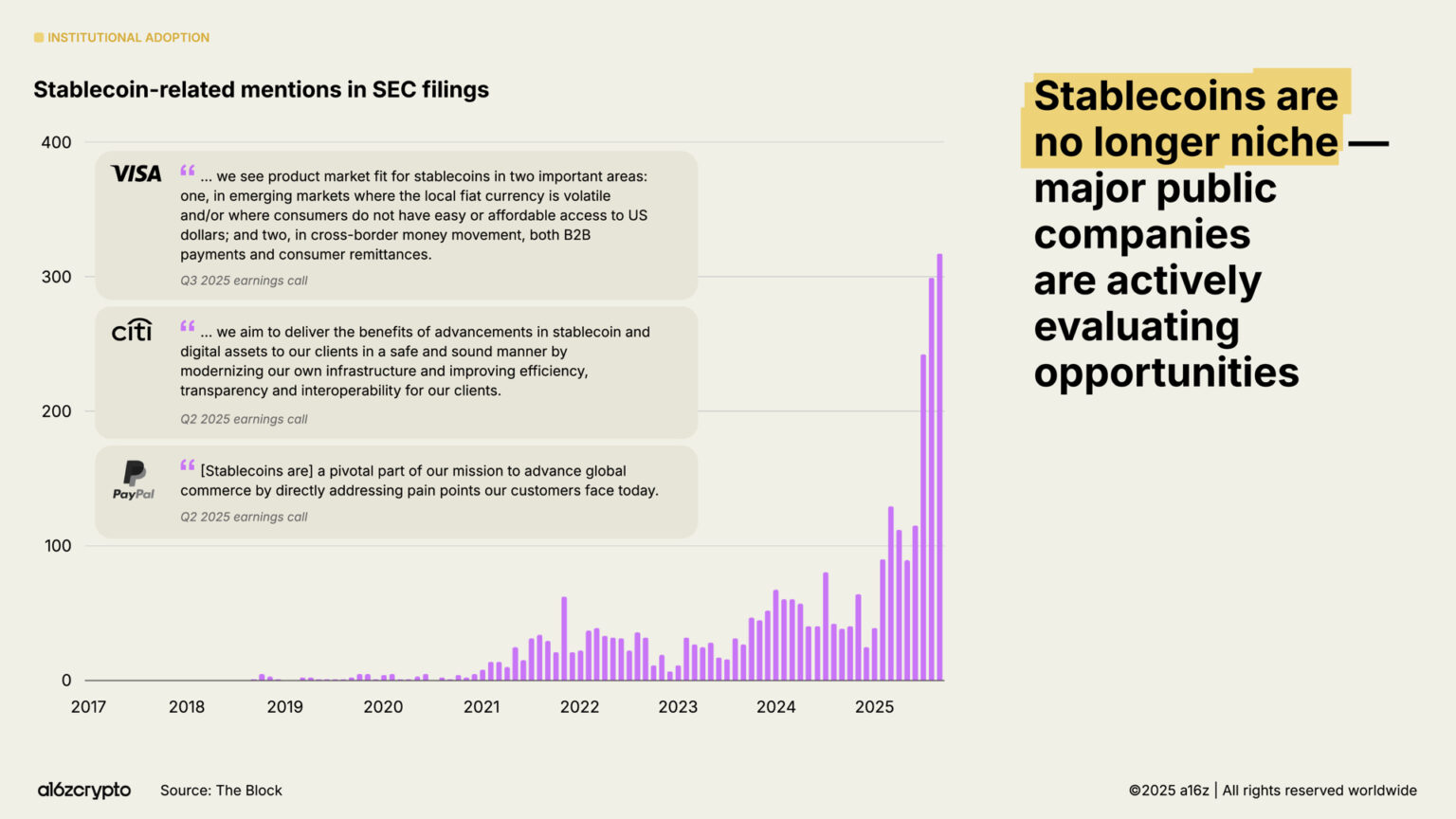
The pace of institutional adoption is rapidly accelerating. Traditional financial giants—including Citigroup, Fidelity, JPMorgan, Mastercard, Morgan Stanley, and Visa—have now begun (or plan) to offer crypto products directly to consumers, allowing users to buy, sell, and hold digital assets on the same platform as trading stocks, ETFs, or other traditional financial products. Meanwhile, platforms like PayPal and Shopify are also doubling down on investments in the payment space, building infrastructure for everyday crypto transactions between merchants and consumers.
In addition to directly offering crypto products, major fintech companies—such as Circle, Robinhood, and Stripe—are also actively developing or have announced plans to develop new blockchain networks, focusing on payments, real-world assets (RWA), and stablecoins. These initiatives will drive more payment flows on-chain, encourage enterprise-level adoption, and ultimately form a larger, faster, and more global financial system.
The biggest advantage of these companies lies in their distribution capabilities. If these developments continue, cryptocurrency will become deeply integrated into the financial services system we use every day.
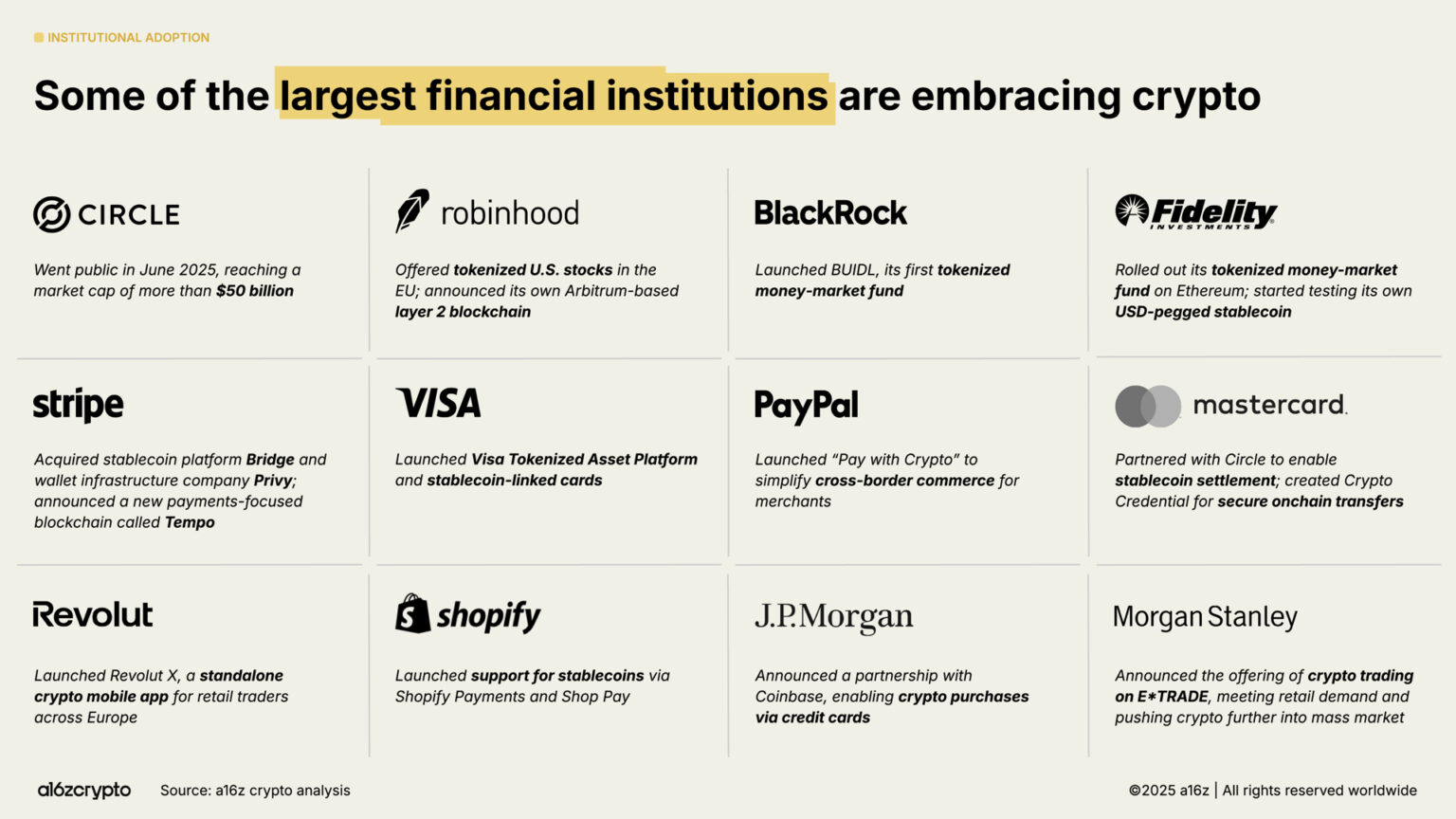
Exchange-traded products (ETPs) are another major driver of institutional investment. To date, on-chain crypto asset holdings have exceeded $175 billion, a 169% increase from $65 billion a year ago.
BlackRock's iShares Bitcoin Trust (IBIT) has become the highest trading volume ETP in history; the subsequently launched Ethereum ETP has also attracted significant inflows in recent months. Although these products are commonly referred to as ETFs (exchange-traded funds), they actually fall under ETPs (exchange-traded products) when registered with the SEC, indicating that their underlying portfolios do not consist of securities.
These products have significantly lowered the barriers for institutions to enter the crypto space, releasing a large amount of institutional capital that had previously been on the sidelines.
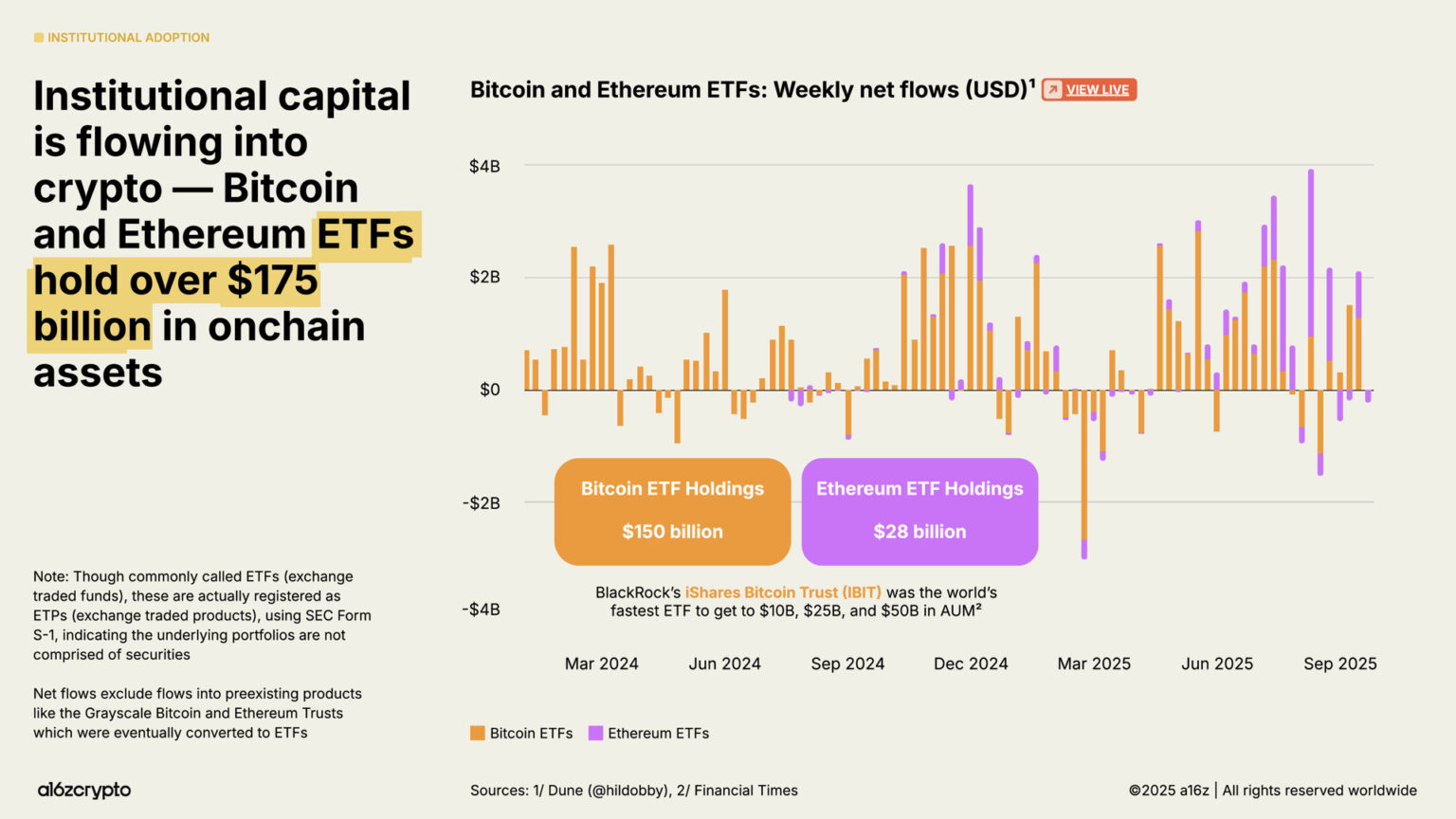
Publicly listed “Digital Asset Treasury” (DAT) companies—those that hold crypto assets on their balance sheets like traditional companies hold cash—now collectively hold about 4% of the circulating total of Bitcoin and Ethereum. When combined with exchange-traded products, they now hold about 10% of the supply of Bitcoin and Ethereum tokens.
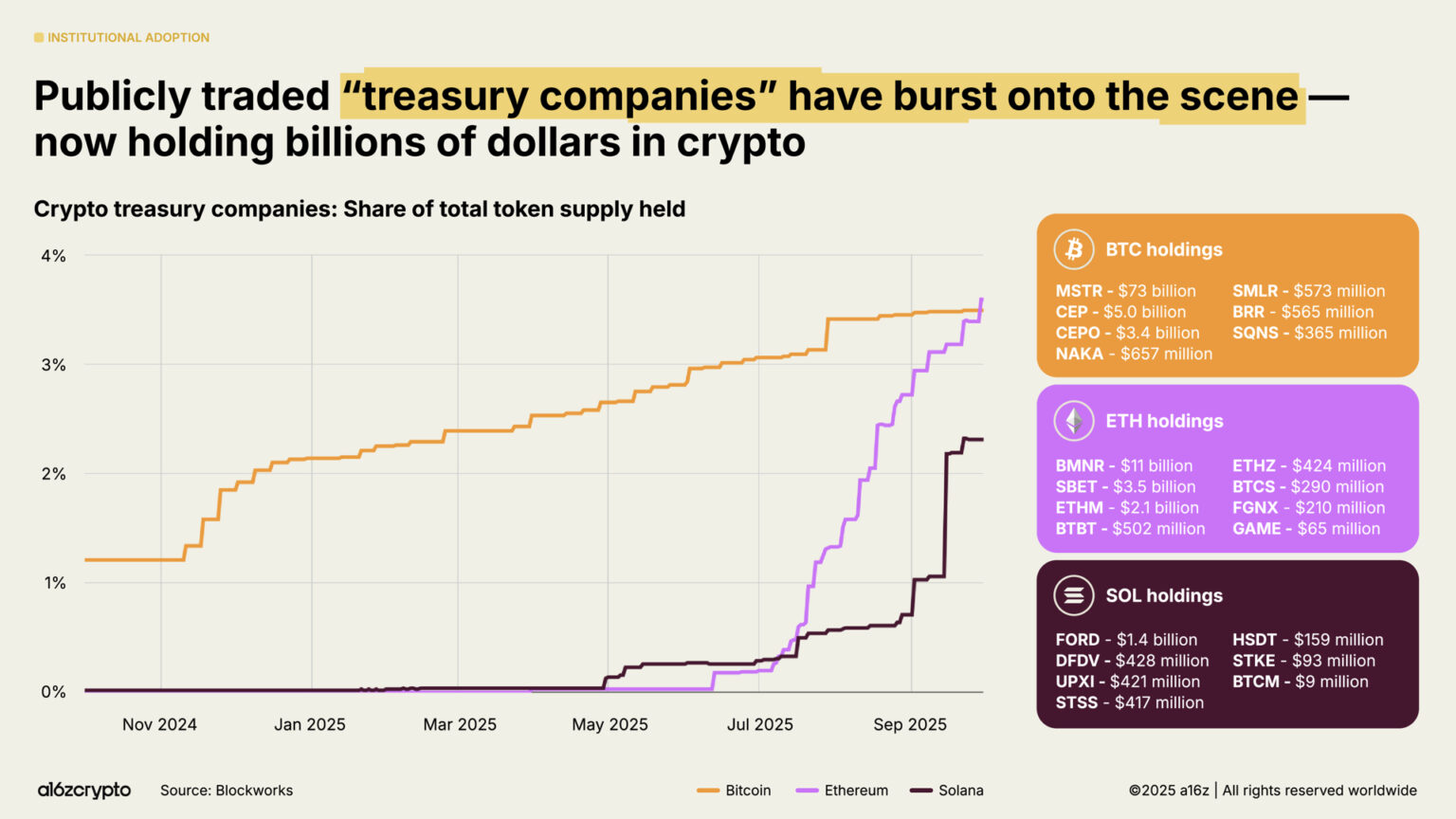
Stablecoins Going Mainstream
Nothing exemplifies the maturity of cryptocurrency in 2025 more than the rise of stablecoins. In recent years, stablecoins were primarily used for settling speculative crypto trades; however, they have now become the fastest, cheapest, and most global way to transmit U.S. dollars—taking less than a second, costing less than a cent, and almost reaching anywhere in the world.
This year, they have become the backbone of the on-chain economy.
Over the past year, the total transaction volume of stablecoins reached $46 trillion, a 106% increase from the previous year. Although this is not a completely equivalent comparison (as this figure mainly represents fund flows, while card networks focus on retail payments), it is nearly three times the transaction volume of Visa and is on track to match the scale of the core clearing network ACH of the entire U.S. banking system.
When adjusted for better organic activity measurement (which filters out bot and other artificially inflated activities), the transaction volume of stablecoins over the past 12 months was $9 trillion, an 87% increase from a year ago. This is equivalent to more than five times the total processed by PayPal and over half of Visa's volume.
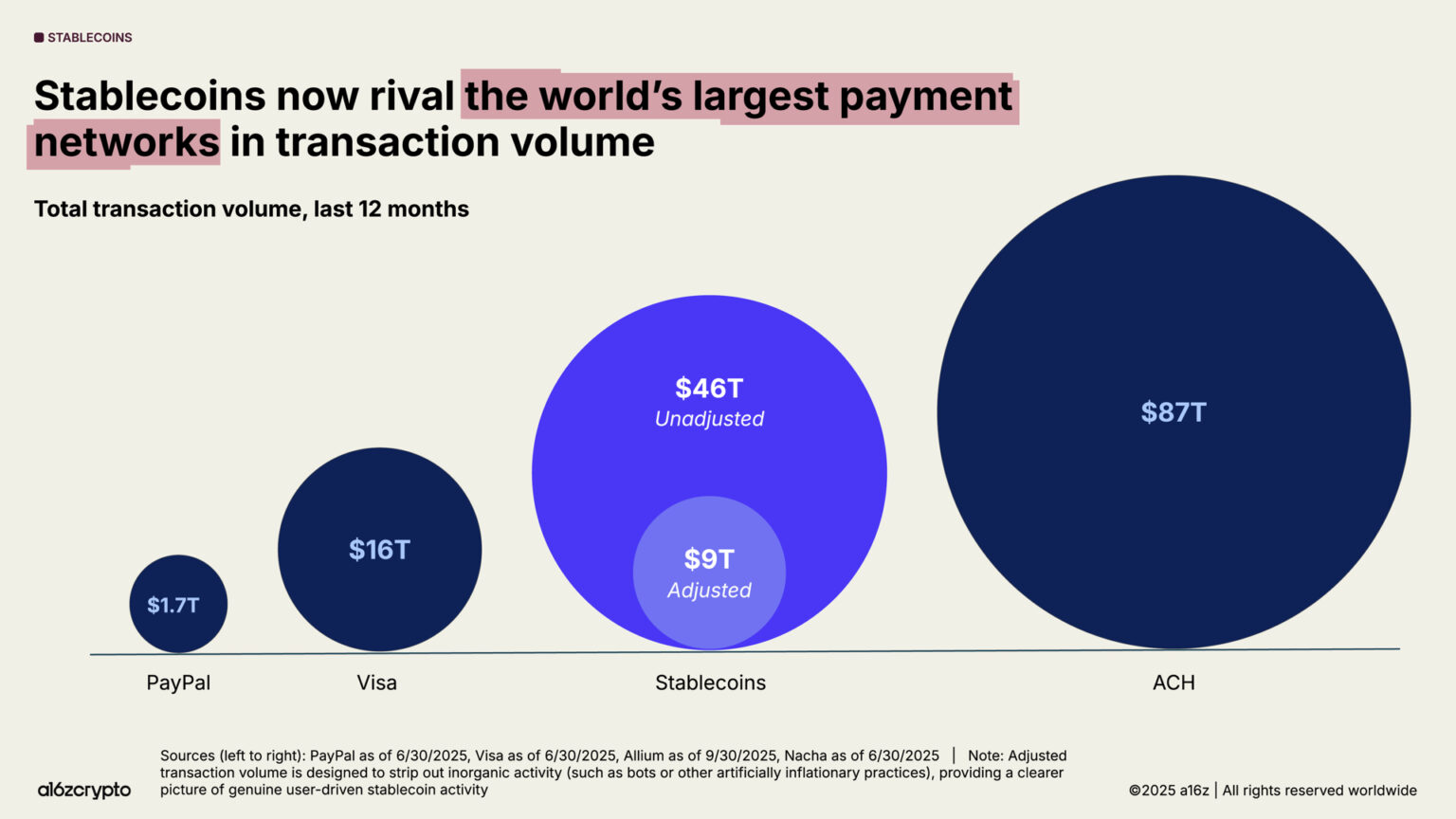
The adoption of stablecoins is accelerating. In September 2025, the adjusted monthly transaction volume of stablecoins reached $1.25 trillion, a historic high. Notably, this growth has almost no correlation with broader cryptocurrency transaction volumes, indicating that the use of stablecoins is not for speculative purposes; more importantly, they have achieved product-market fit.
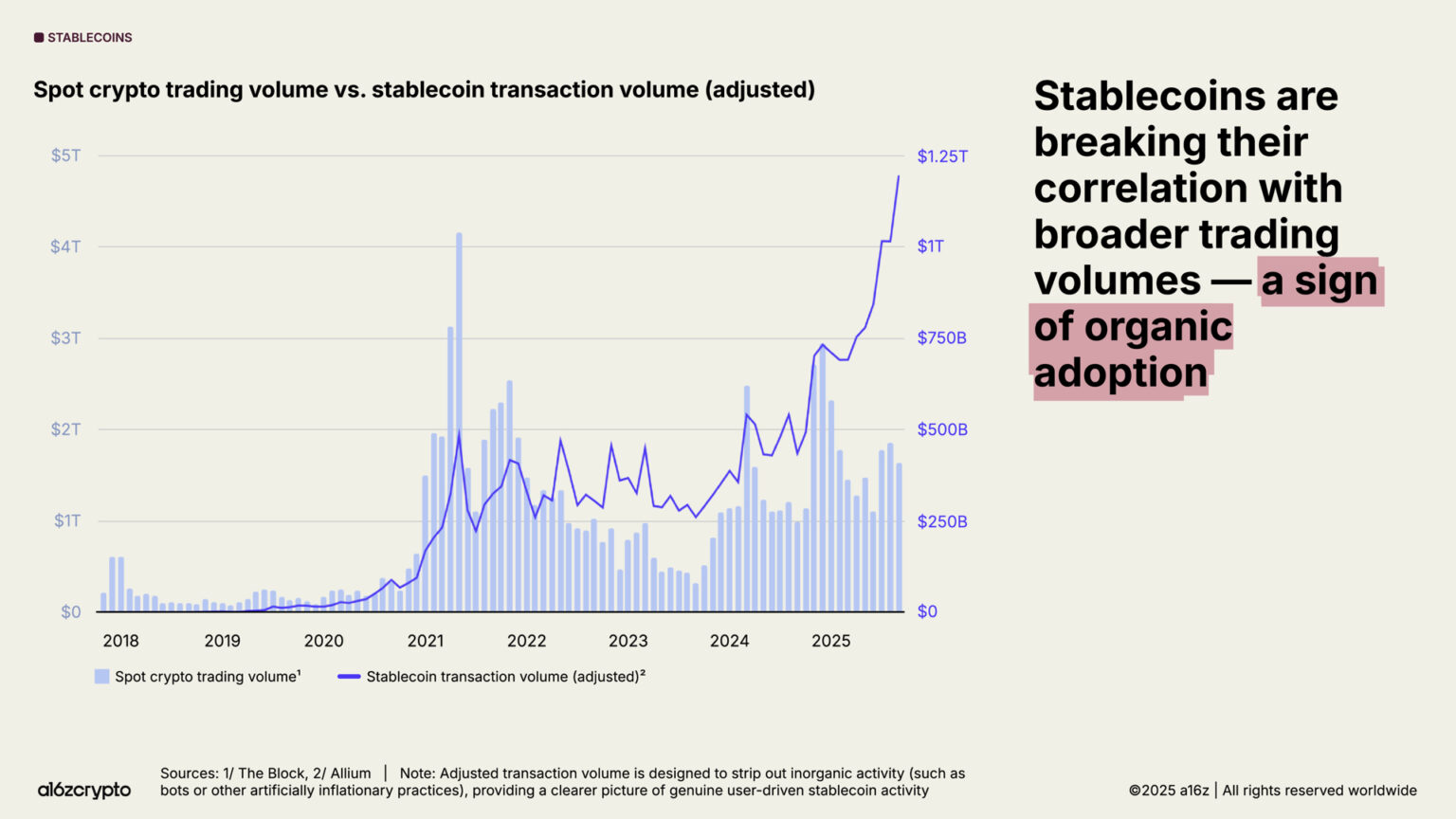
The total supply of stablecoins is also at an all-time high, currently exceeding $300 billion, with the two largest stablecoins, USDT and USDC, accounting for 87% of the total supply. In September 2025, $772 billion in stablecoin transaction volume (adjusted) was settled on just the Ethereum and Tron blockchains, accounting for 64% of all transaction volume. While these two issuers and public chains still dominate stablecoin activity, the growth momentum of emerging public chains and new issuers is also rapidly increasing.
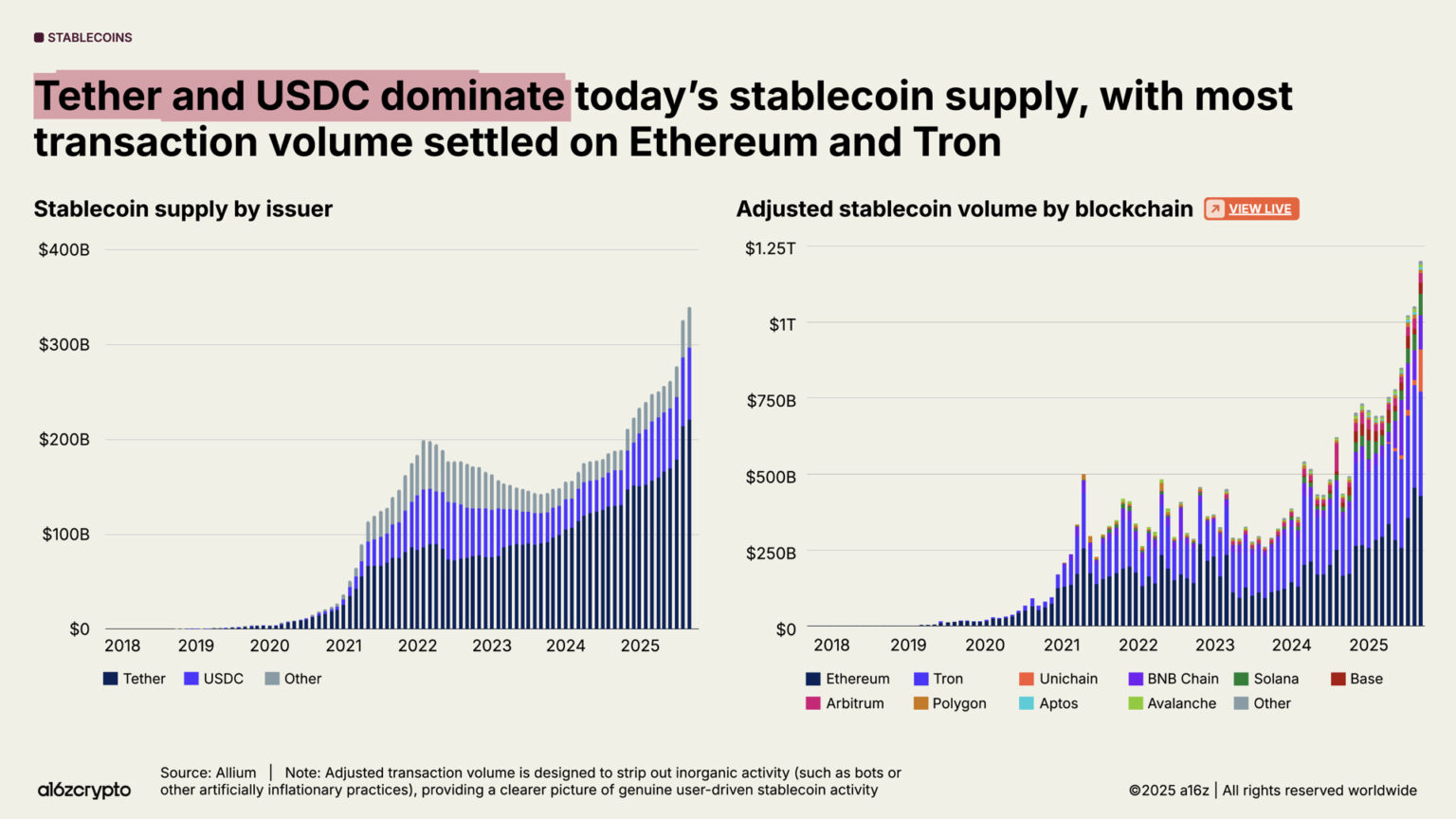
Today, stablecoins have become a global macroeconomic force—over 1% of the global U.S. dollar circulation now exists in tokenized stablecoin form on public blockchains. Additionally, stablecoins have become the 17th largest holder of U.S. Treasury bonds, rising three places from last year (when it was 20th). Overall, stablecoins currently hold over $150 billion in U.S. Treasury bonds—this scale exceeds that of many sovereign nations' bond reserves.
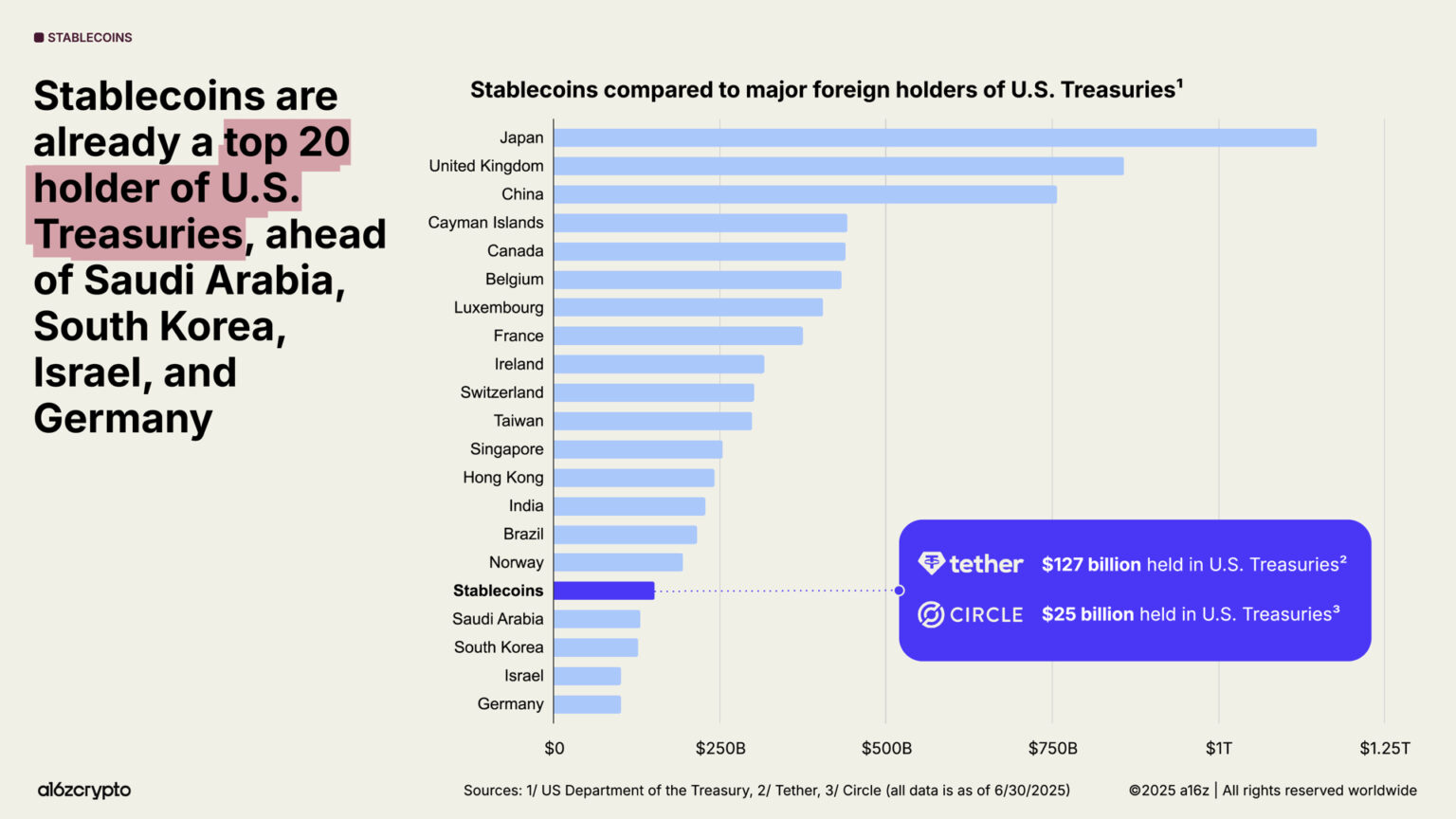
Meanwhile, the scale of U.S. Treasury bonds continues to soar, while global demand for this debt is declining. For the first time in thirty years, central banks have more gold holdings in their foreign exchange reserves than U.S. Treasury holdings.
However, stablecoins are going against the trend. Currently, over 99% of stablecoins are dollar-denominated, and it is expected that by 2030, their total scale will grow more than tenfold, surpassing $3 trillion.
This means that in the coming years, stablecoins could become a strong and sustainable source of demand for U.S. debt. Even if foreign central banks continue to reduce their holdings of U.S. Treasuries, stablecoins are reinforcing the global dominance of the dollar.
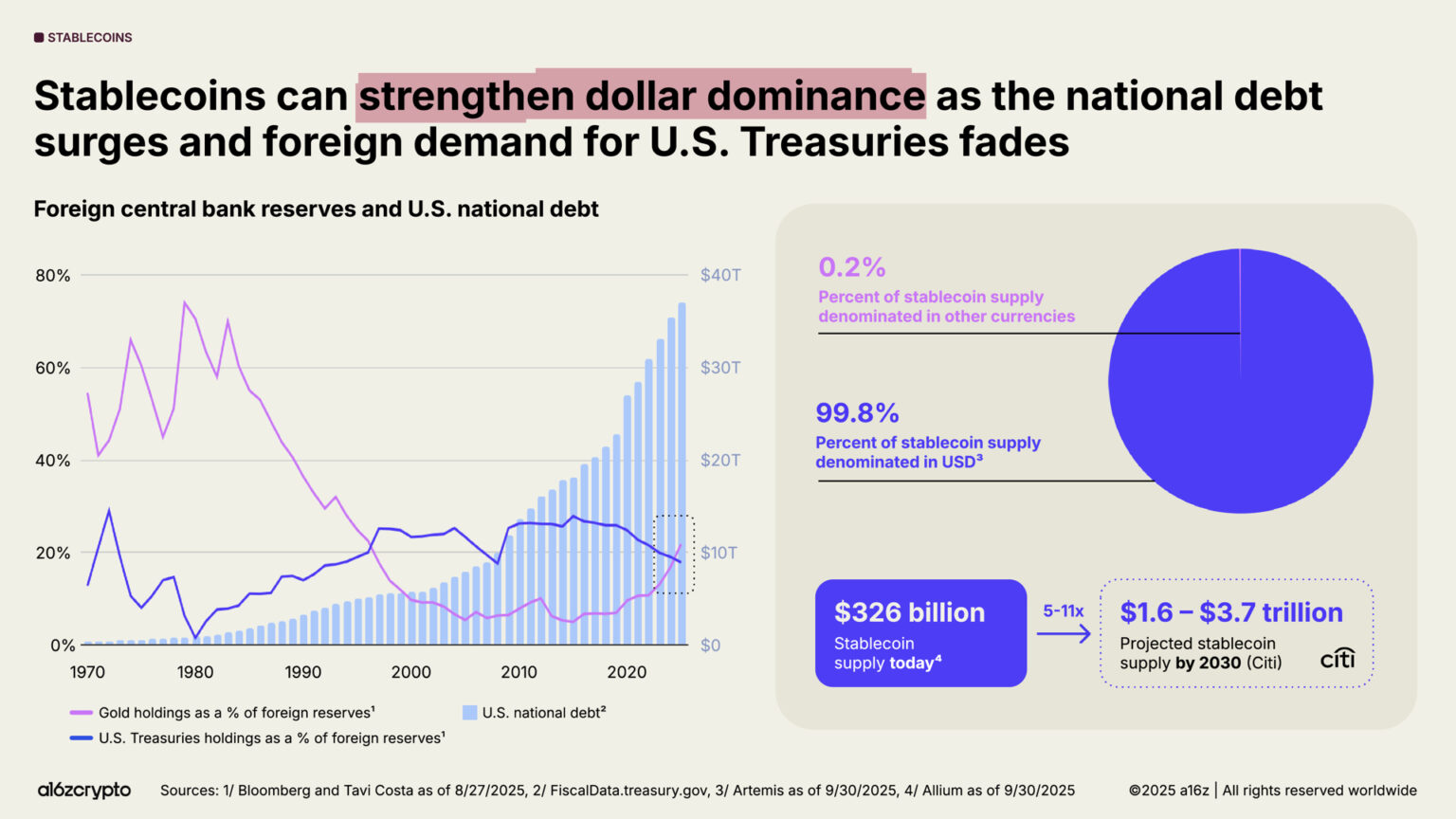
The Influence of Cryptocurrency in the U.S. is Unprecedented
The U.S. has reversed its previously adversarial stance on cryptocurrency, rebuilding the confidence of builders.
The passage of the “GENIUS” bill this year and the House's approval of the “CLARITY” bill mark a rare bipartisan consensus in the U.S.—the crypto industry is not only here to stay but is also experiencing prosperous development domestically.
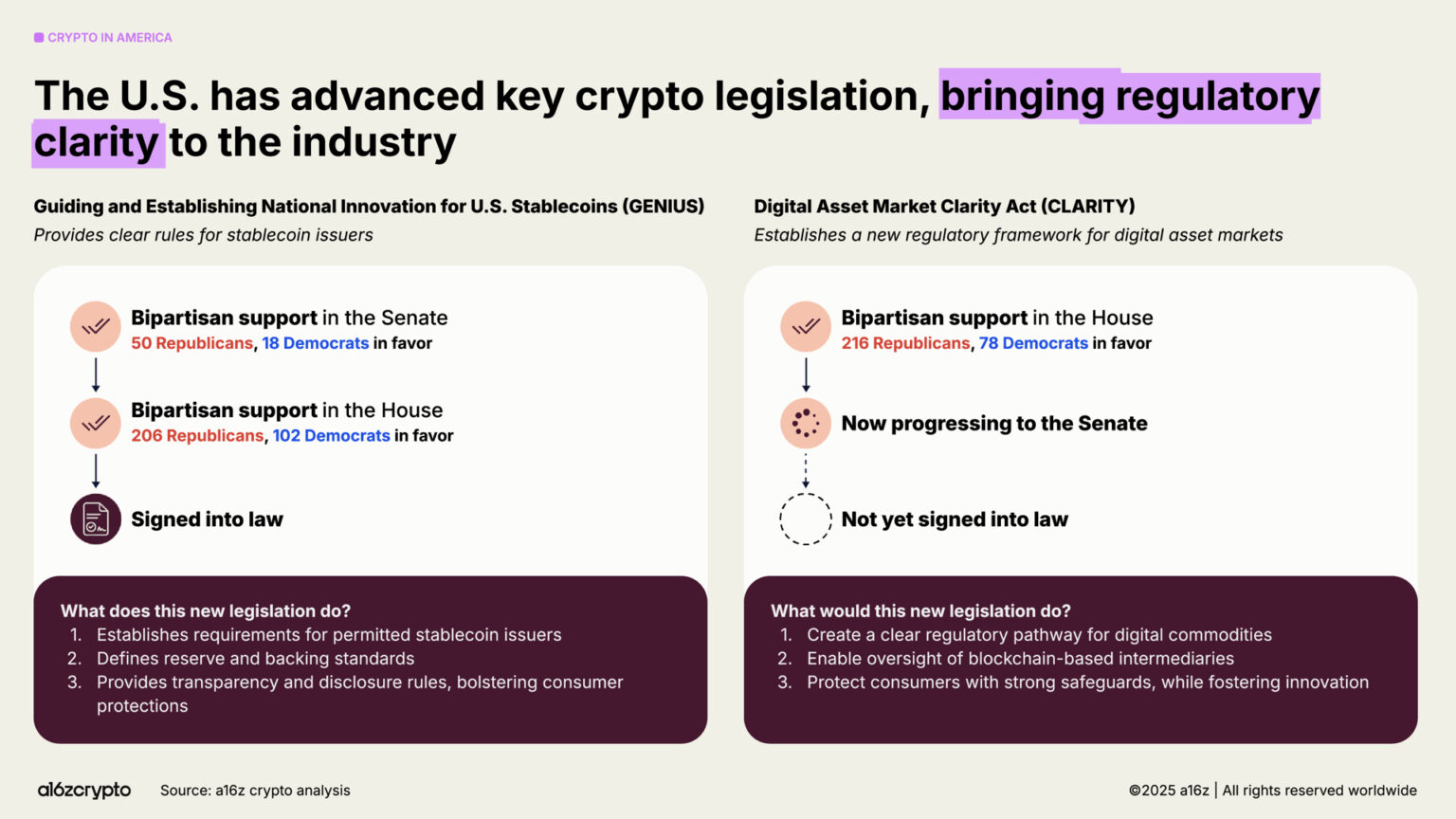
These bills collectively construct a framework for stablecoin regulation, market structure, and digital asset oversight, balancing innovation with investor protection. Meanwhile, Executive Order 14178 further strengthens this shift—this order rescinds previous anti-crypto policy directives and establishes an interagency digital asset working group to modernize federal-level digital asset policy.
Now, the regulatory environment is paving the way for builders, allowing them to truly unleash the potential of tokens as a new digital primitive—just as websites once did for the last generation of the internet. With a clear regulatory framework, more network tokens will be able to close their economic loops, create revenue through network activity, and return profits to token holders. This will give rise to a self-sustaining new type of internet economic engine that is not only more sustainable but also allows more users to genuinely share in the economic rights of the entire system.
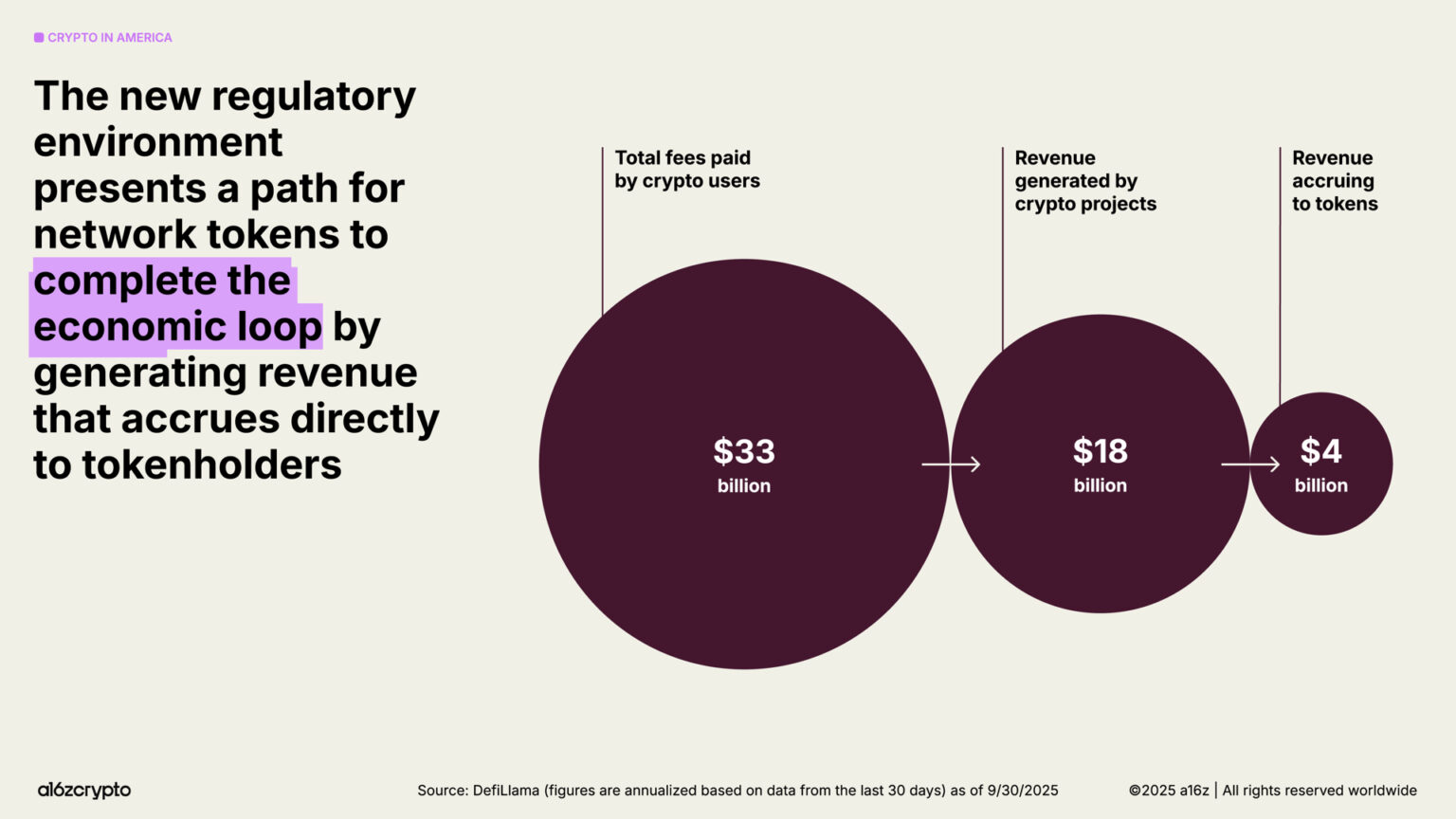
The World is Moving On-Chain
The on-chain economy—which was once just a niche testing ground for early adopters—has now evolved into a vast market spanning multiple industries, with tens of millions of active participants each month. Today, nearly one-fifth of spot trading volume is conducted on decentralized exchanges (DEX).
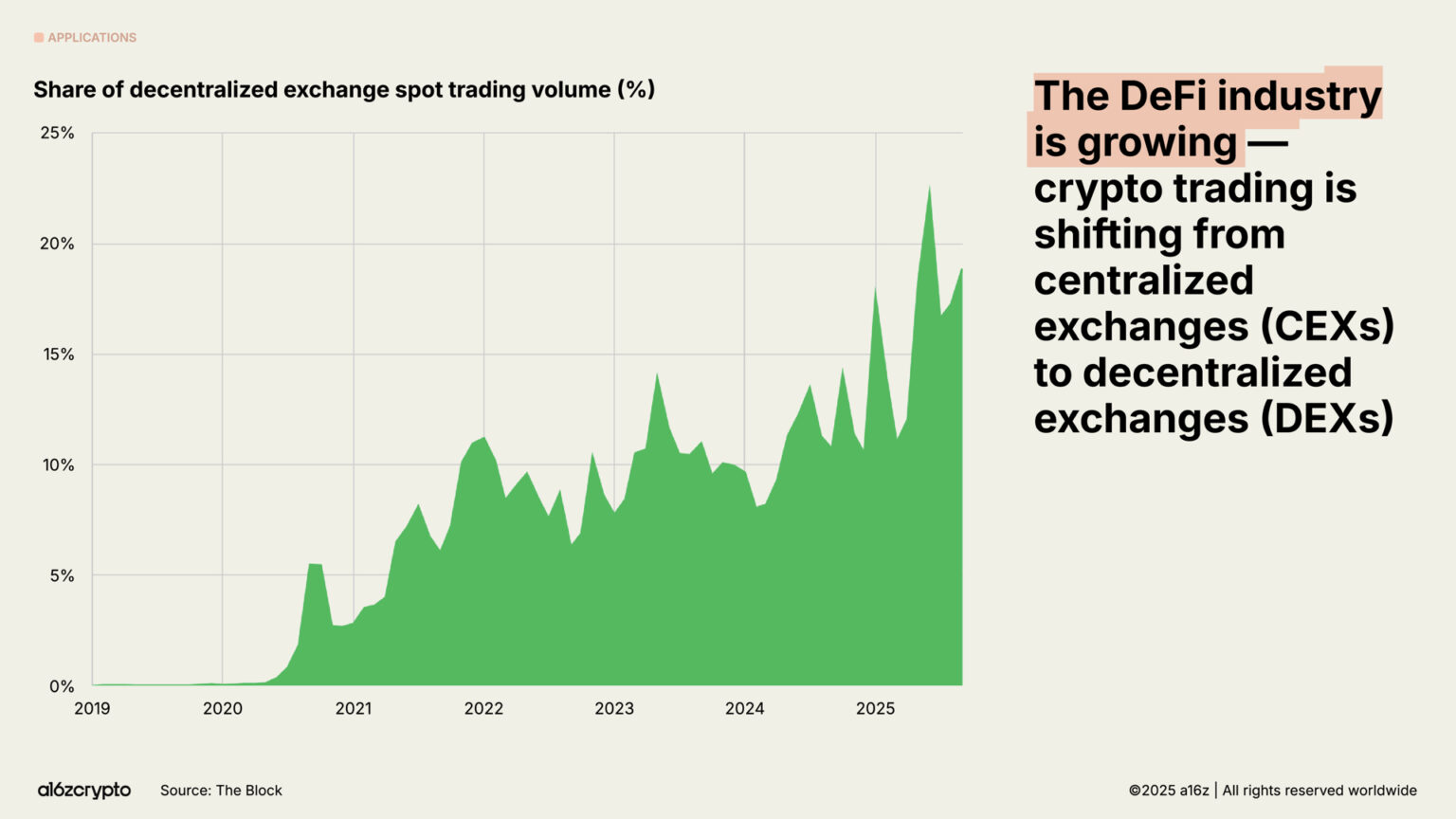
In the past year, the trading volume of perpetual contracts has grown nearly 8 times, becoming one of the most popular trading categories among cryptocurrency speculators.
Decentralized perpetual contract exchanges like Hyperliquid have processed trillions of dollars in trading volume this year, achieving over $1 billion in annualized revenue—this scale is comparable to some centralized exchanges.
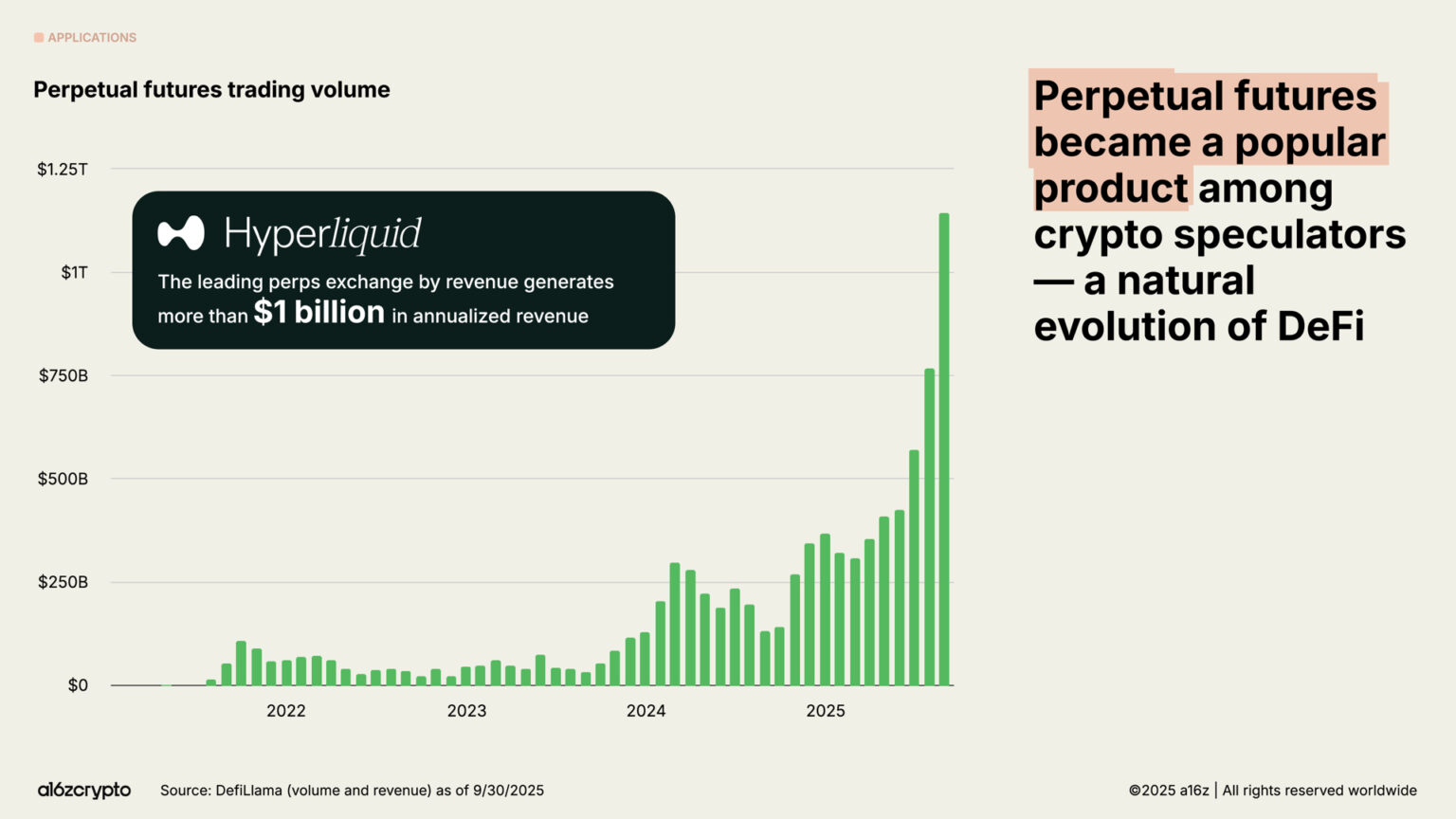
Real-world assets (RWA)—those traditional financial assets that have been tokenized, such as U.S. Treasury bonds, money market funds, private credit, and real estate—are connecting the crypto world with the traditional financial system. Currently, the market size of tokenized real-world assets has reached $30 billion, growing nearly 4 times in the past two years.
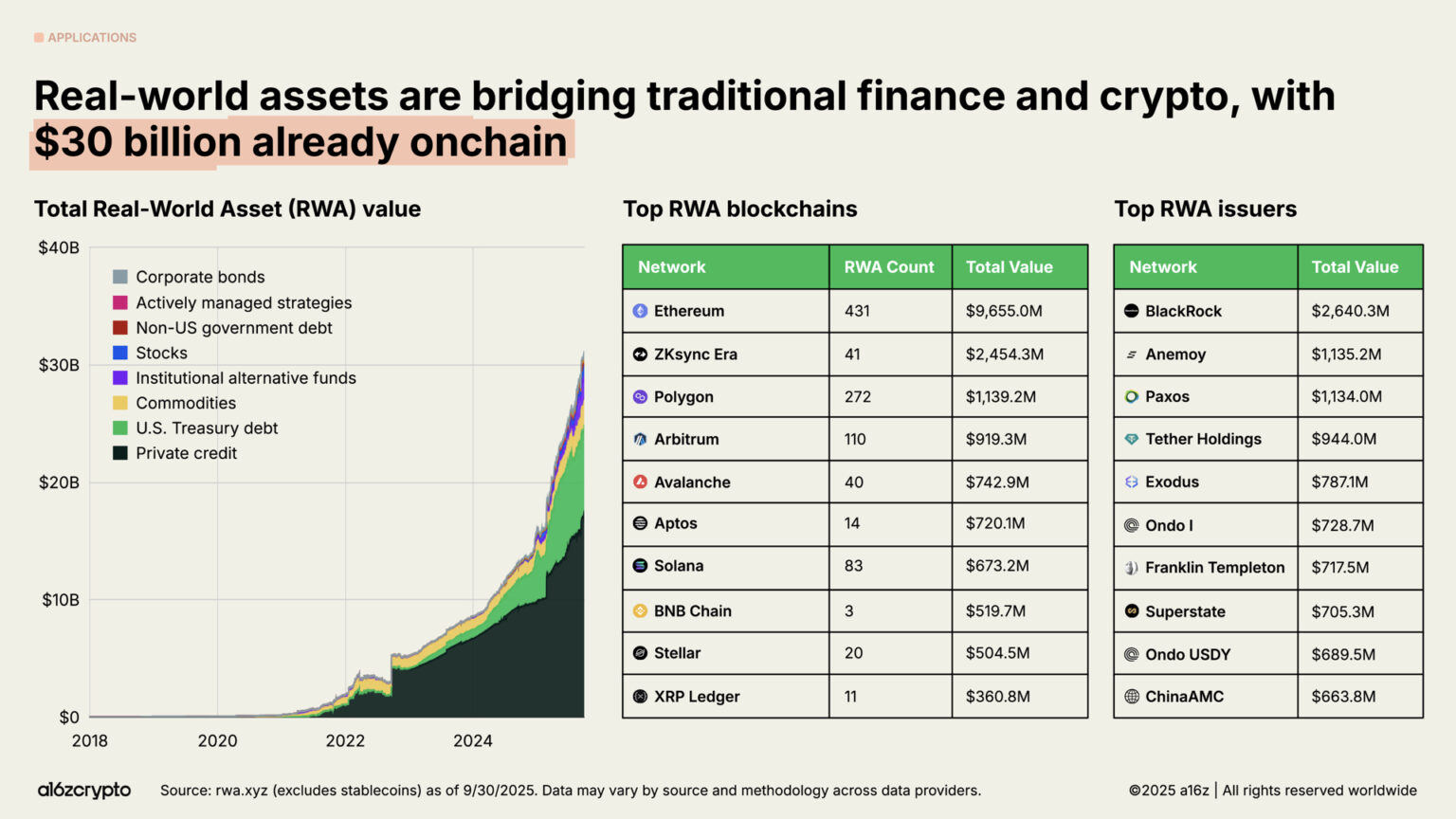
Beyond the financial sector, one of the most ambitious frontiers for blockchain in 2025 is DePIN (Decentralized Physical Infrastructure Networks). Just as DeFi redefined finance, DePIN is reshaping real-world infrastructure—covering communication networks, transportation systems, energy grids, and more. The potential in this field is enormous—the World Economic Forum (WEF) predicts that by 2028, the market size of the DePIN sector will reach $3.5 trillion.
The Helium network is one of the most well-known cases. This user-operated decentralized wireless network now provides 5G cellular coverage to 1.4 million active users daily through over 110,000 hotspots operated by users.
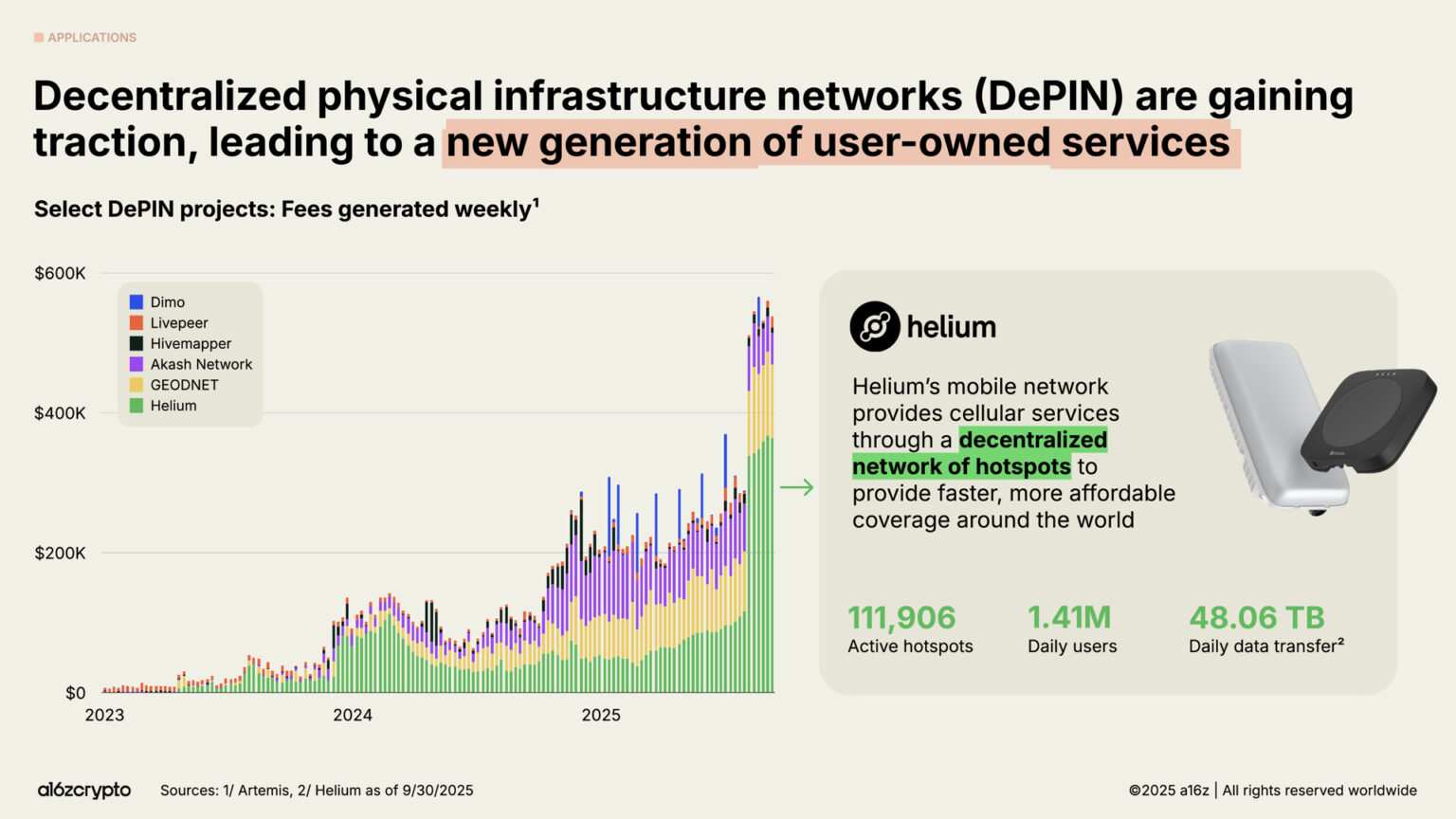
Prediction markets are officially entering the mainstream during the 2024 U.S. presidential election cycle. The monthly total trading volume of the most popular platforms, Polymarket and Kalshi, has reached billions of dollars. Although there are doubts about whether these platforms can maintain their popularity in non-election years, their trading volume has increased nearly 5 times since the beginning of 2025, approaching historical highs.
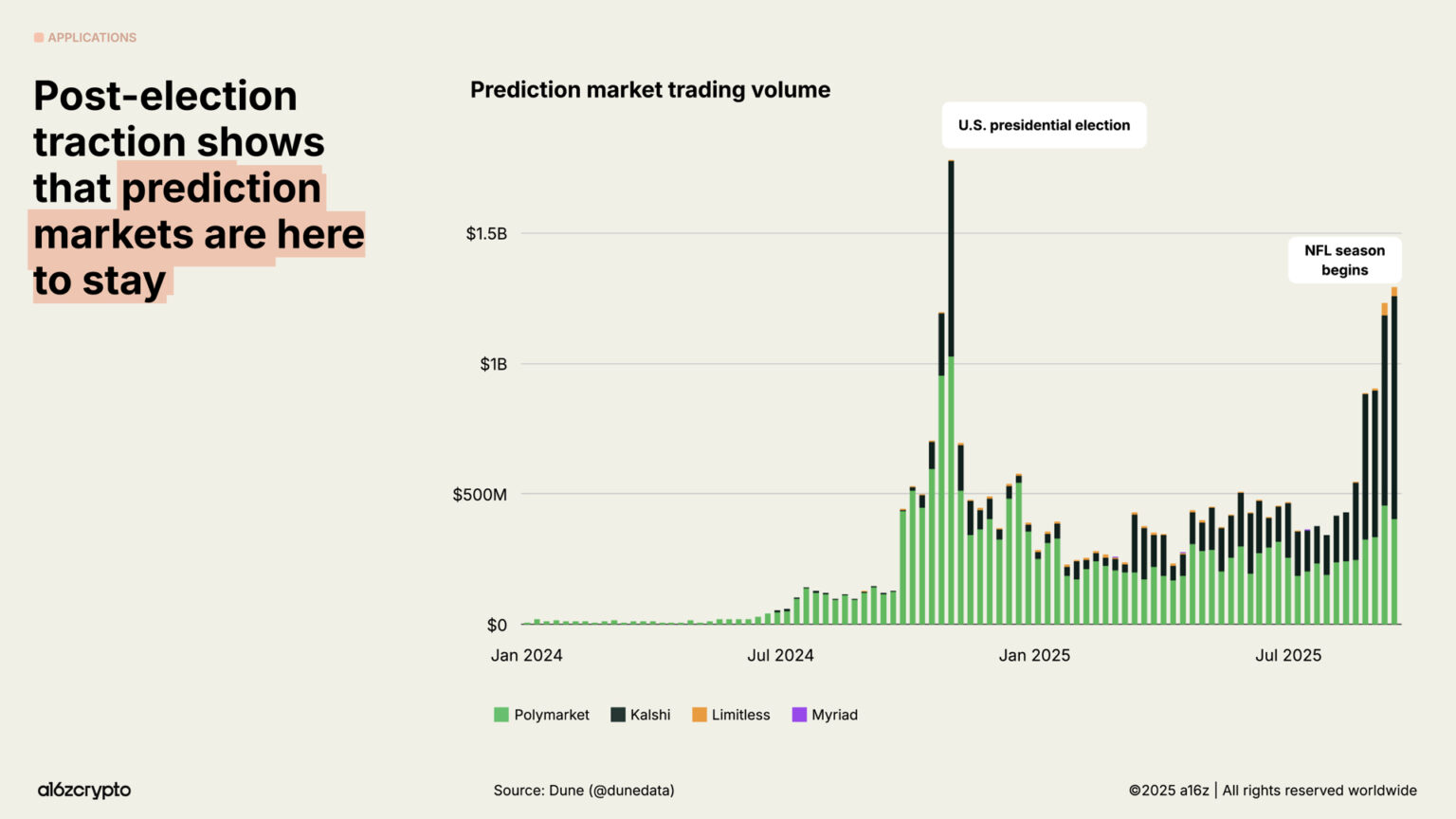
During a period of regulatory uncertainty, meme coins have experienced explosive growth. In just the past year, over 13 million new meme coins have been launched. However, this trend has begun to noticeably cool in recent months—the number of launches in September 2025 decreased by 56% compared to January. As a more robust policy framework and bipartisan legislative consensus gradually take shape, the cryptocurrency industry is making room for more productive blockchain application scenarios.
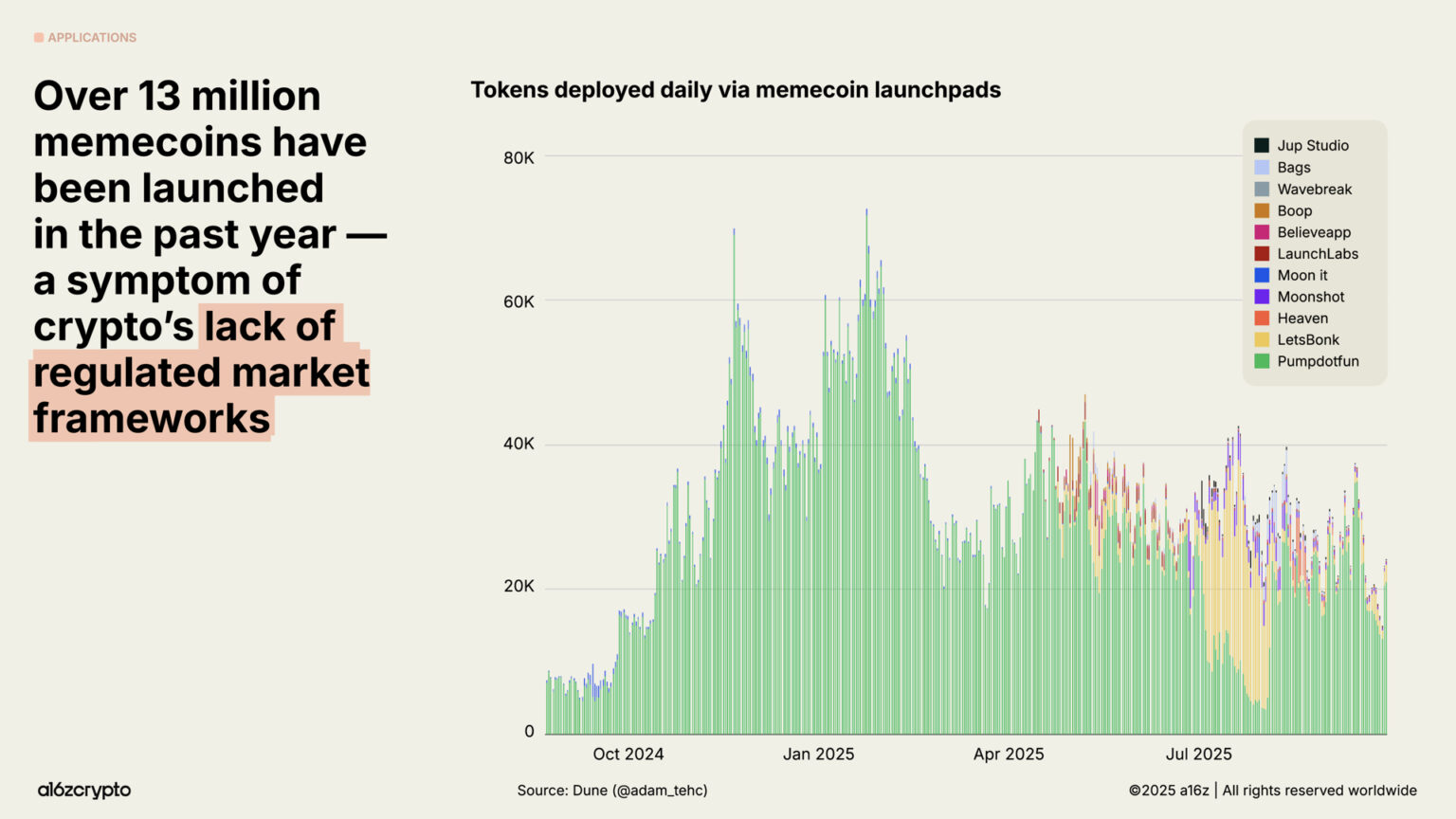
The overall trading volume of the NFT market, while far from the peaks of 2022, is seeing a steady increase in the number of monthly active buyers. These trends seem to indicate a shift in consumer behavior from speculation to collecting, with cheaper on-chain block space provided by networks like Solana and Base facilitating this transition.
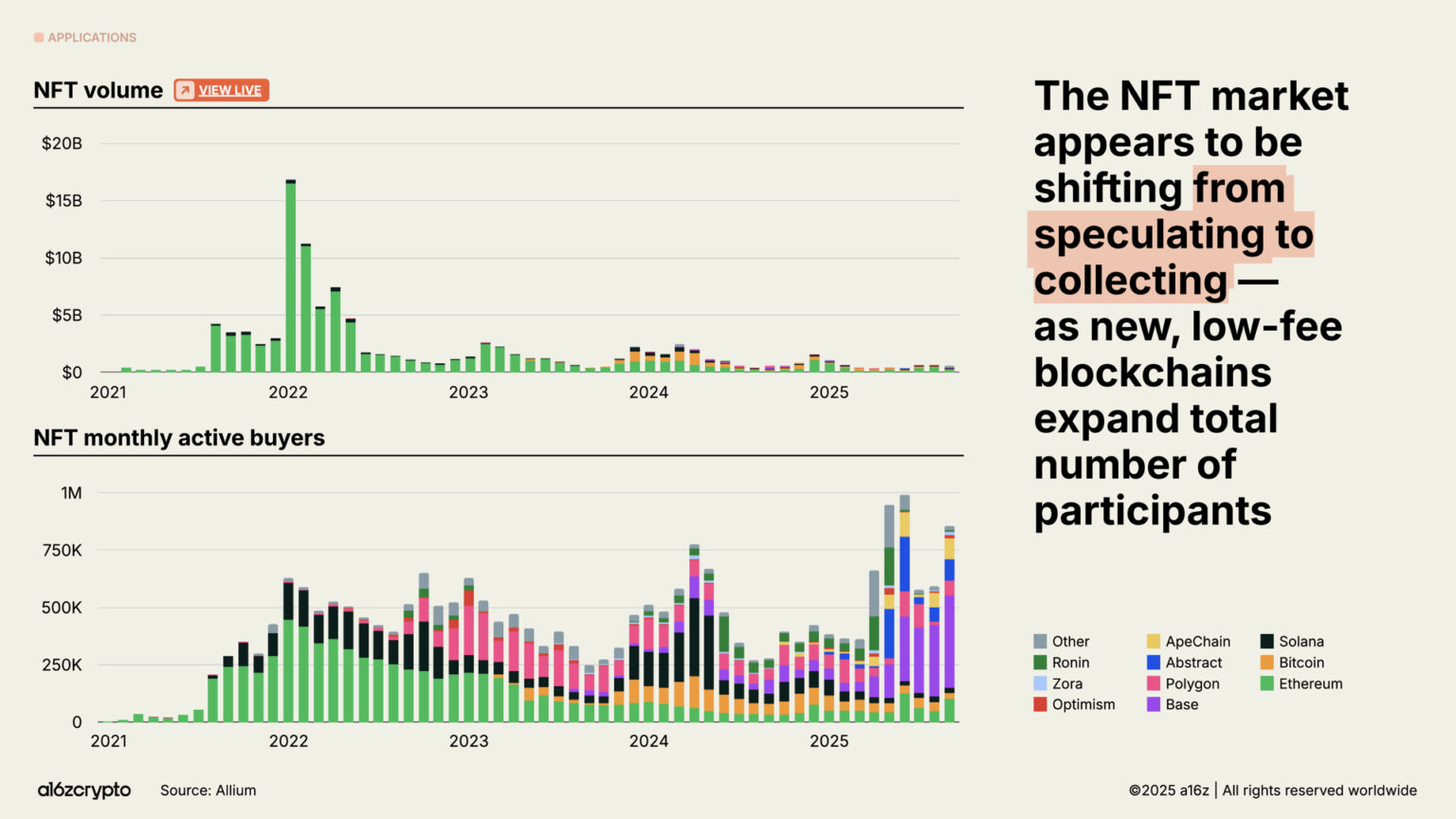
Blockchain Infrastructure is Ready for Prime Time
None of the above developments would be possible without significant advancements in blockchain infrastructure.
In just five years, the overall transaction throughput (TPS) of major blockchain networks has increased by more than 100 times. In the past, the number of transactions processed per second was less than 25; today, blockchains can handle 3,400 transactions per second, with performance now comparable to that of Nasdaq and even approaching the global payment throughput of Stripe during "Black Friday"—all at a fraction of the previous costs.
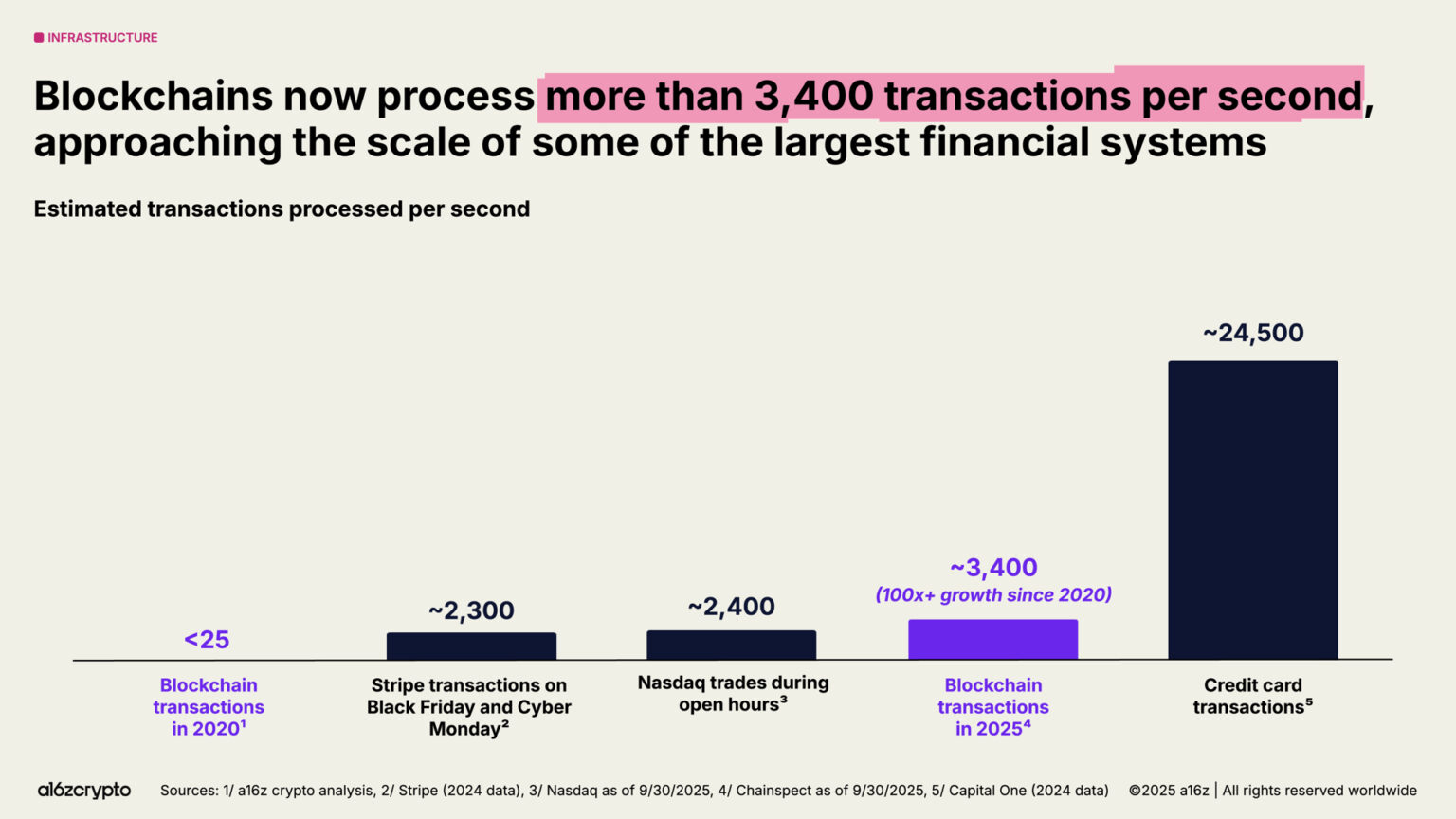
Among various blockchain ecosystems, Solana has emerged as one of the most representative public chains, supporting a wide range of applications from DePIN projects to NFT markets with its high-performance, low-cost architecture. In just the past year, native applications on Solana have generated over $3 billion in revenue. Planned system upgrades on Solana are set to double network capacity by the end of the year.
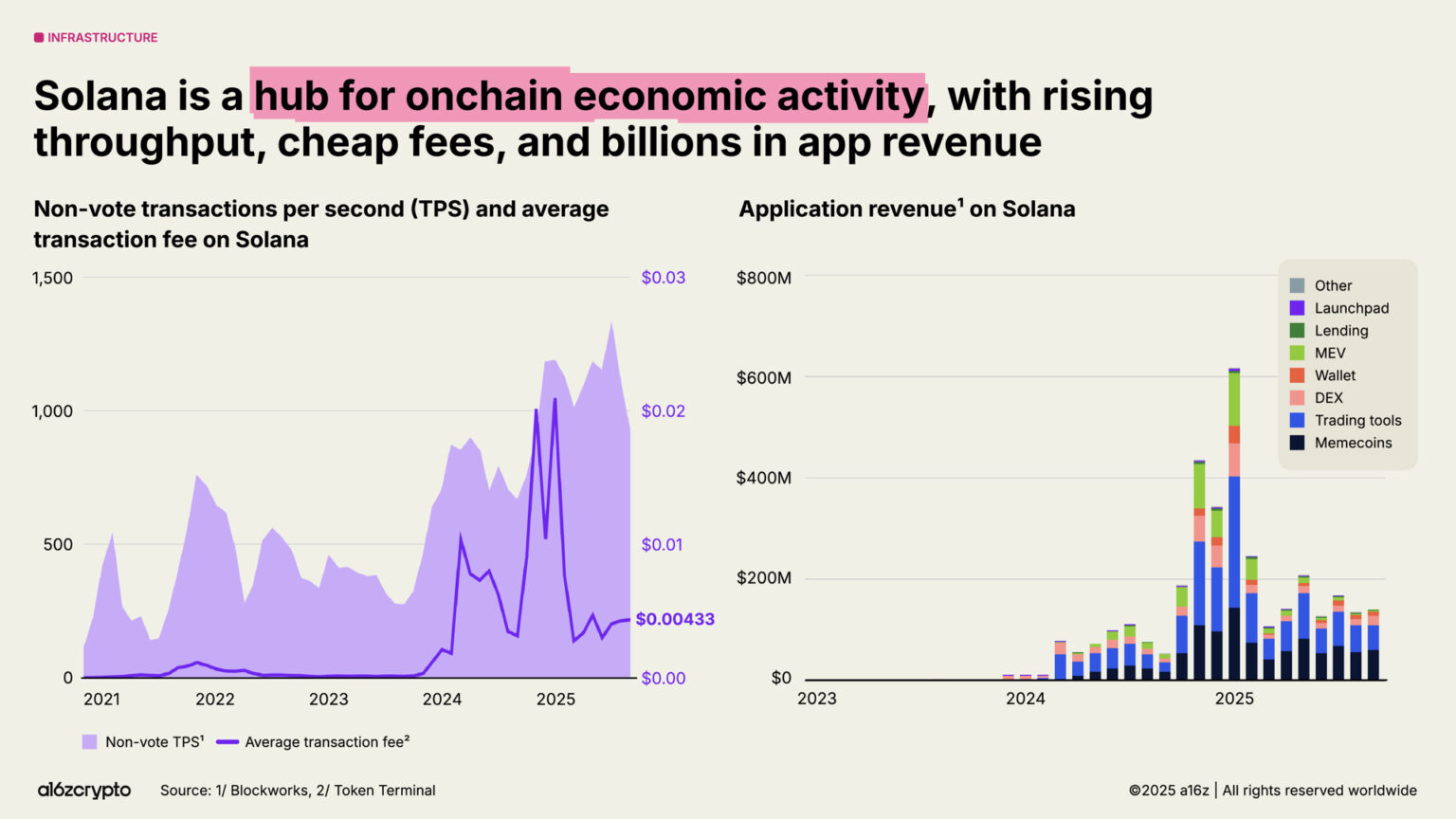
Ethereum continues to advance its scalability roadmap. Currently, most economic activity on Ethereum has migrated to Layer 2 solutions like Arbitrum, Base, and Optimism. The average transaction fees on these Layer 2 solutions have dropped from about $24 in 2021 to less than 1 cent today, making Ethereum-based block space both cheap and abundant.
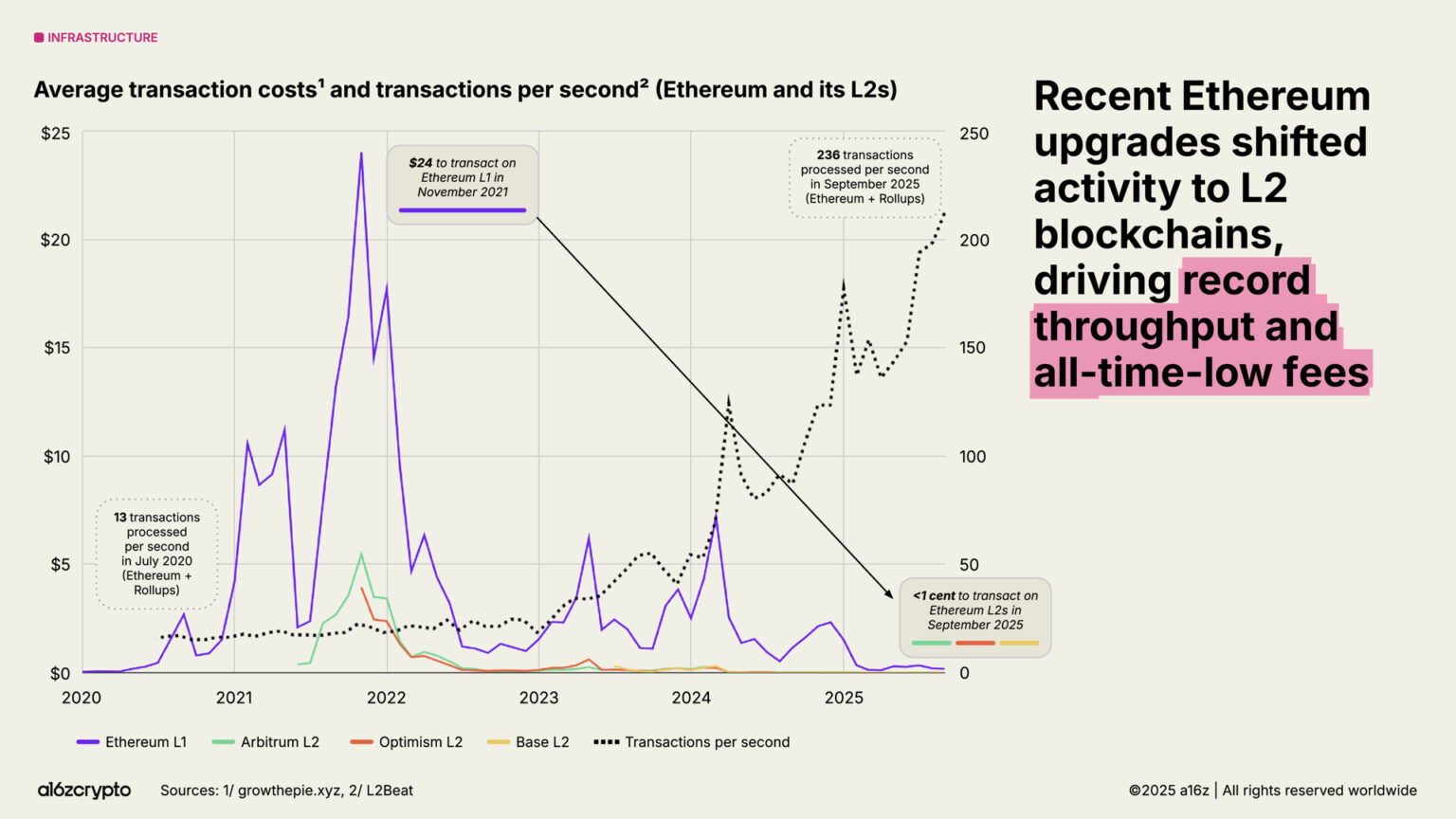
Cross-chain bridges are enabling interoperability between different blockchains. For example, LayerZero and Circle's Cross-Chain Transfer Protocol allows users to freely transfer assets within multi-chain systems. Additionally, Hyperliquid's main bridge has seen a trading volume of $74 billion this year.
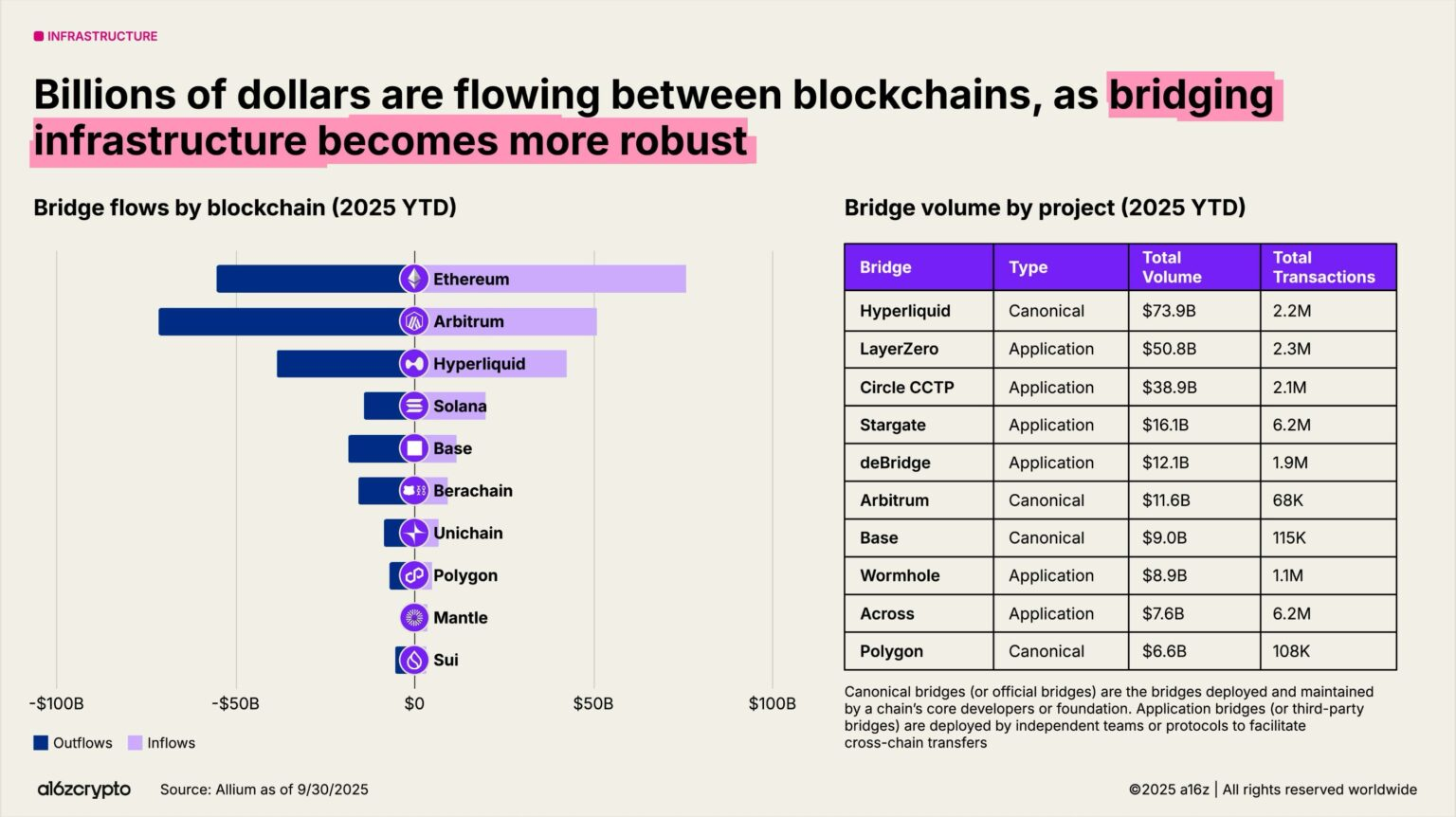
Privacy is regaining focus in the cryptocurrency space and may become a prerequisite for broader adoption. Several signs indicate a rising public interest—search volumes related to "crypto privacy" surged in 2025; the supply of Zcash's privacy pool grew to nearly 4 million ZEC; and Railgun's monthly transaction volume also exceeded $200 million.
More positive signals include the Ethereum Foundation establishing a new privacy team; Paxos partnering with Aleo to launch a compliant privacy stablecoin (USAD); and the U.S. Office of Foreign Assets Control lifting sanctions on the decentralized privacy protocol Tornado Cash… We expect this trend to gain further momentum in the coming years as cryptocurrency technology continues to go mainstream.
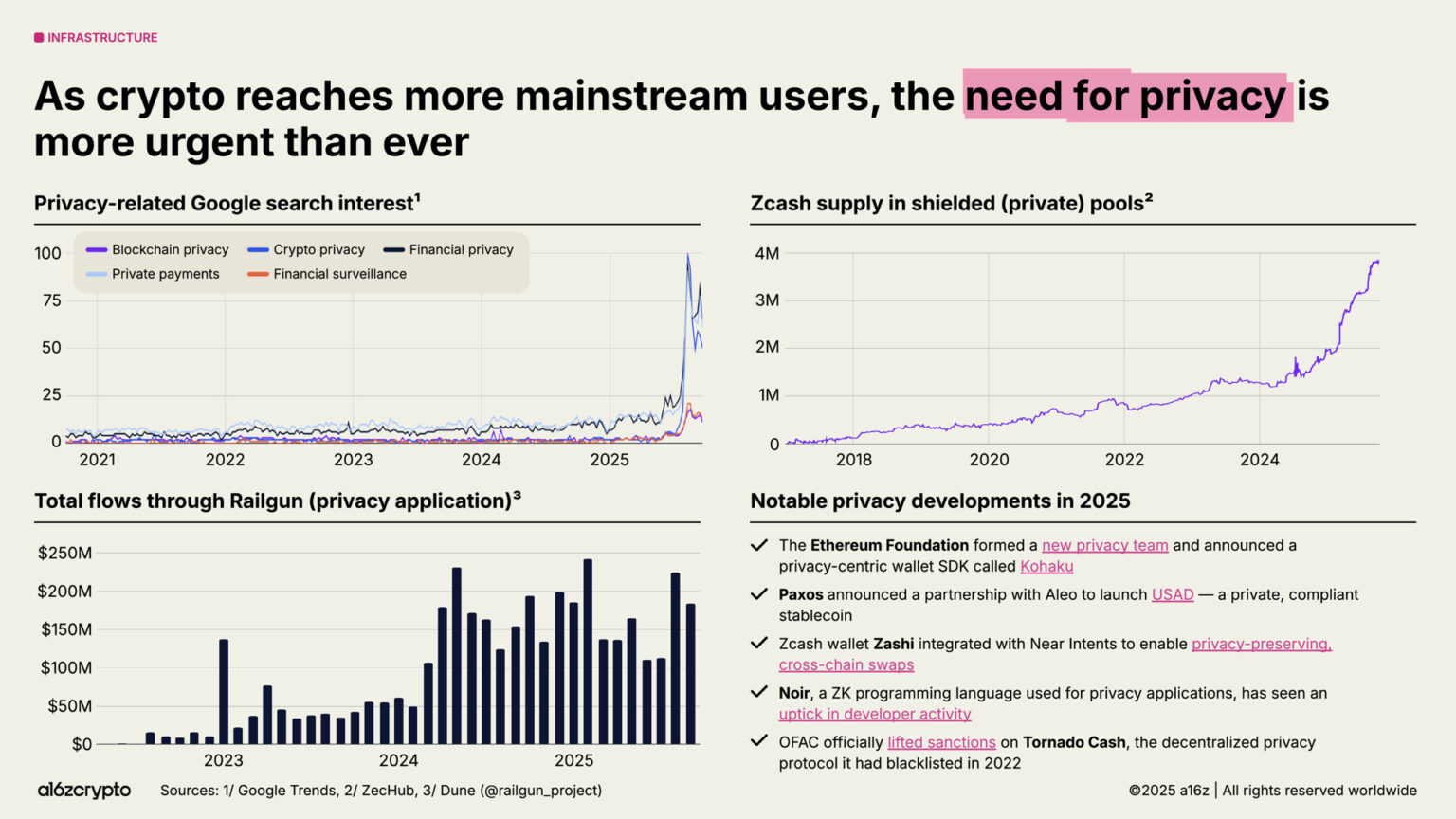
Similarly, zero-knowledge proofs (ZK) and succinct proof systems are rapidly evolving from decades of academic research into key infrastructure for blockchains. Today, ZK technology is widely integrated into Rollup scaling solutions, compliance tools, and even mainstream internet services—one typical example being Google's ZK identity system.
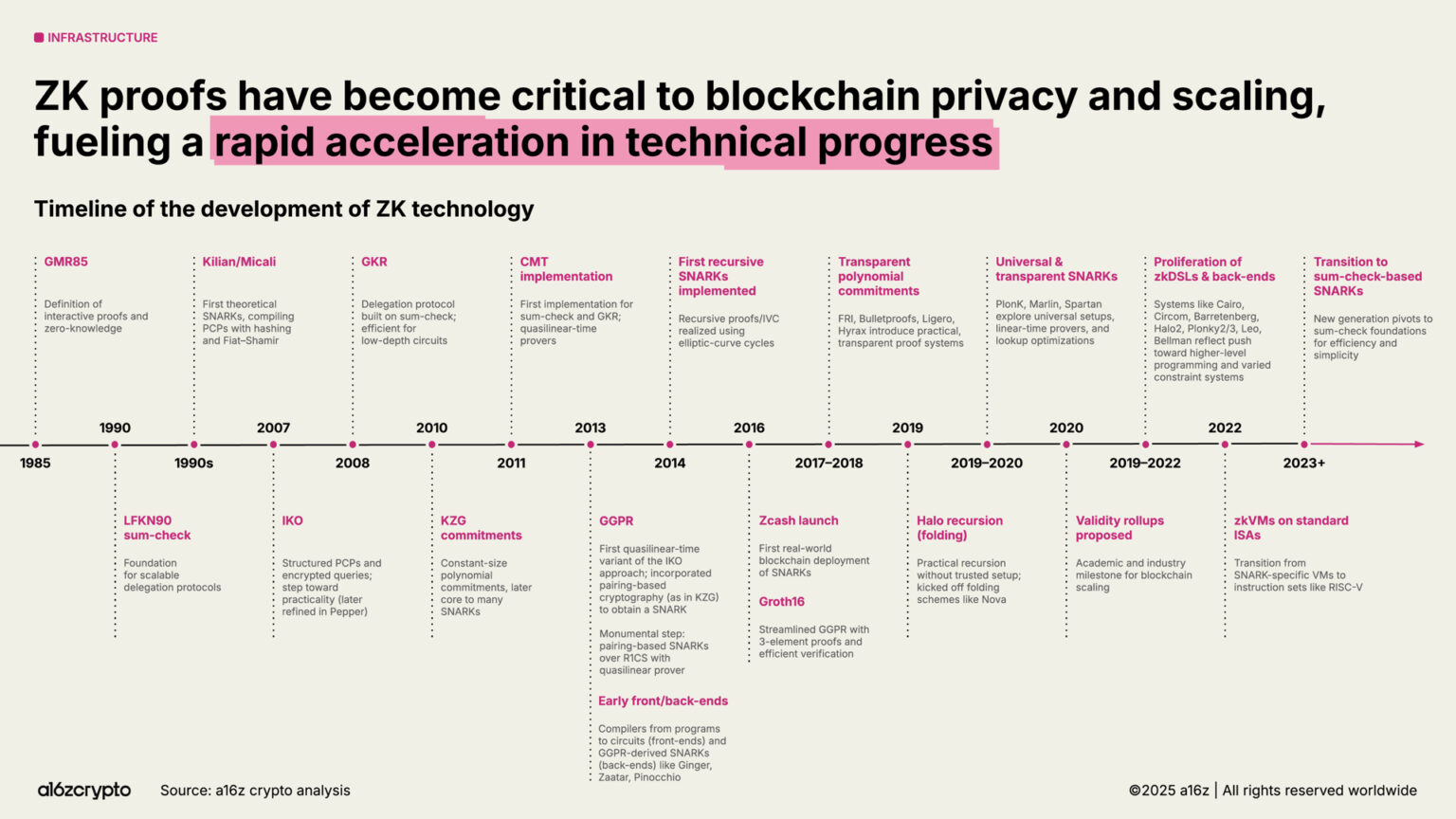
Meanwhile, blockchain is accelerating its roadmap for quantum resistance. Currently, about $750 billion worth of Bitcoin is stored in addresses that may be vulnerable to quantum attacks. The U.S. government plans to fully migrate its federal systems to post-quantum cryptographic algorithms by 2035.
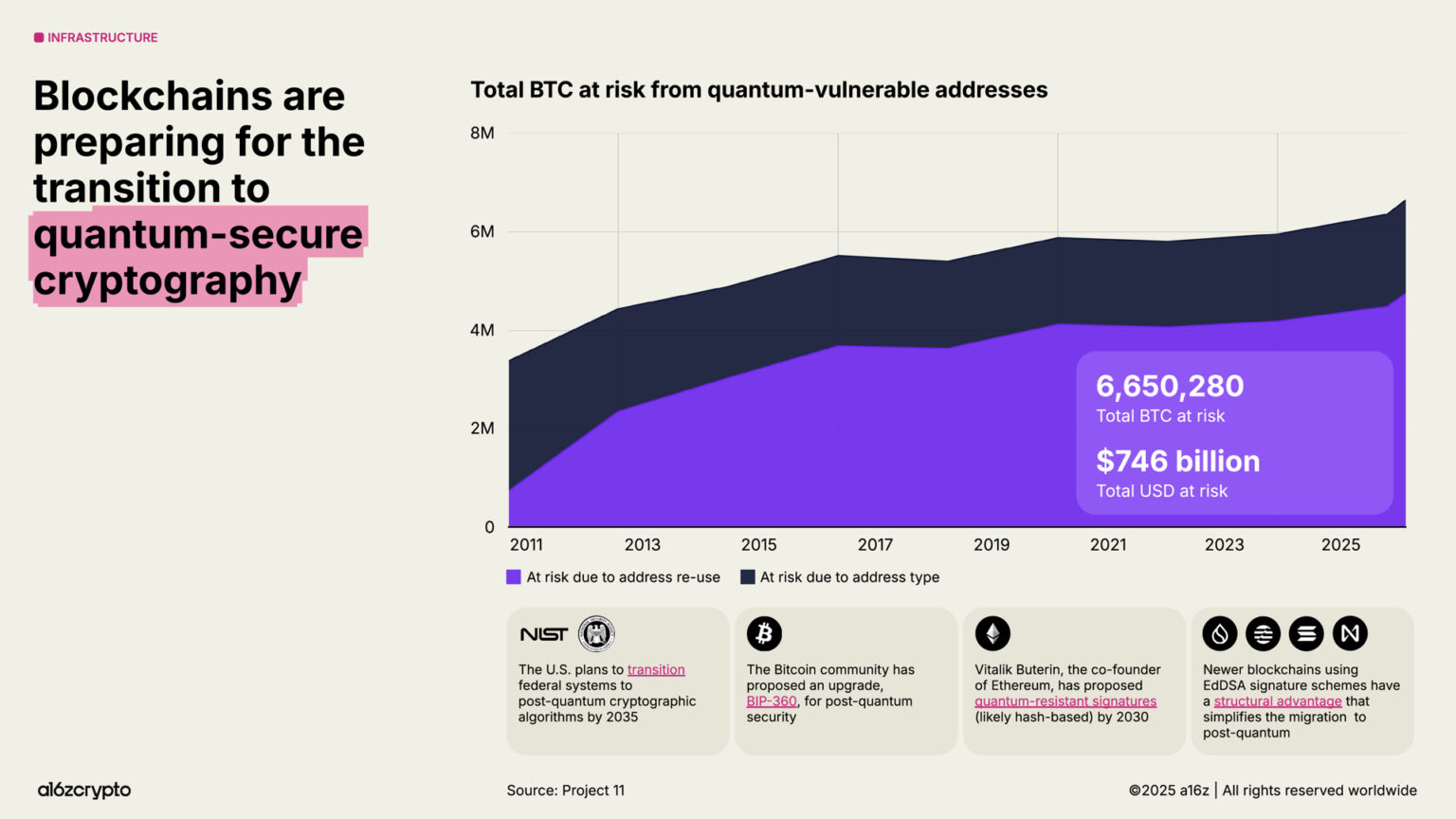
Cryptocurrency and Artificial Intelligence are Merging
Among various technological advancements, the release of ChatGPT in 2022 brought artificial intelligence (AI) into the public spotlight—this also presents significant opportunities for the crypto industry. From tracking data provenance and intellectual property licensing to providing payment channels for agents, crypto technology may become a key solution to the most pressing issues in AI.
Decentralized identity systems like World, which have verified over 17 million users, can provide "human proof" and help distinguish between humans and robots.
Protocol standards like x402 are emerging, seen as potential financial infrastructure for autonomous AI agents, helping these agents execute micropayments, access APIs, and complete settlements without intermediaries. According to Gartner, this AI-driven economy could reach a scale of $30 trillion by 2030.
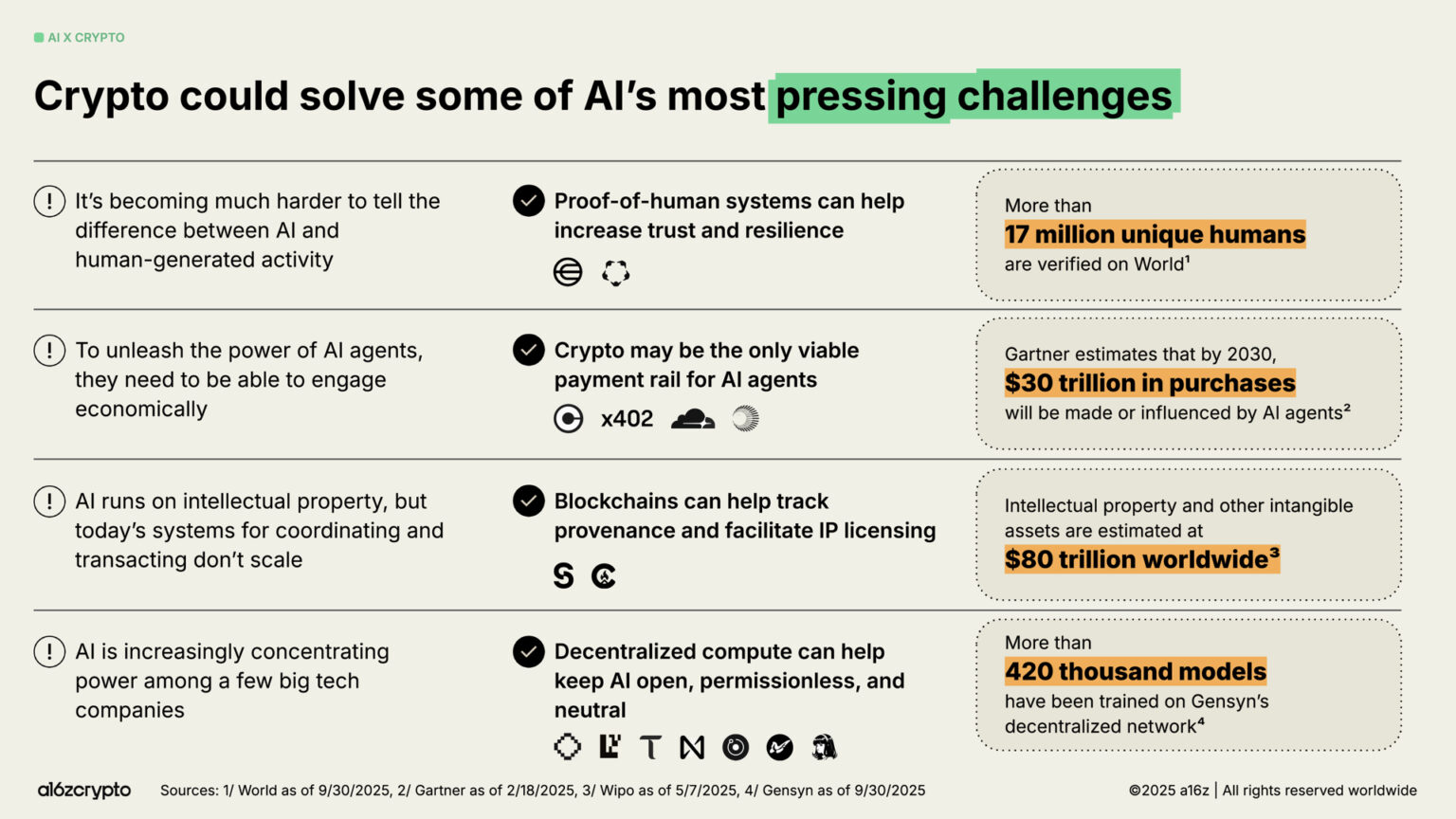
At the same time, the compute layer for AI is increasingly monopolized by a few tech giants, raising concerns about centralization and censorship. Just OpenAI and Anthropic alone control 88% of the revenue from "AI-native" companies; Amazon, Microsoft, and Google control 63% of the cloud infrastructure market; and NVIDIA dominates 94% of the data center GPU market. This structural imbalance has allowed the so-called "Magnificent 7" to achieve double-digit quarterly net profit growth over the past few years, while the remaining 493 companies in the S&P 500 have generally failed to keep up with inflation in profit growth.
Blockchain technology provides a counterbalance to the centralization trend in AI systems.
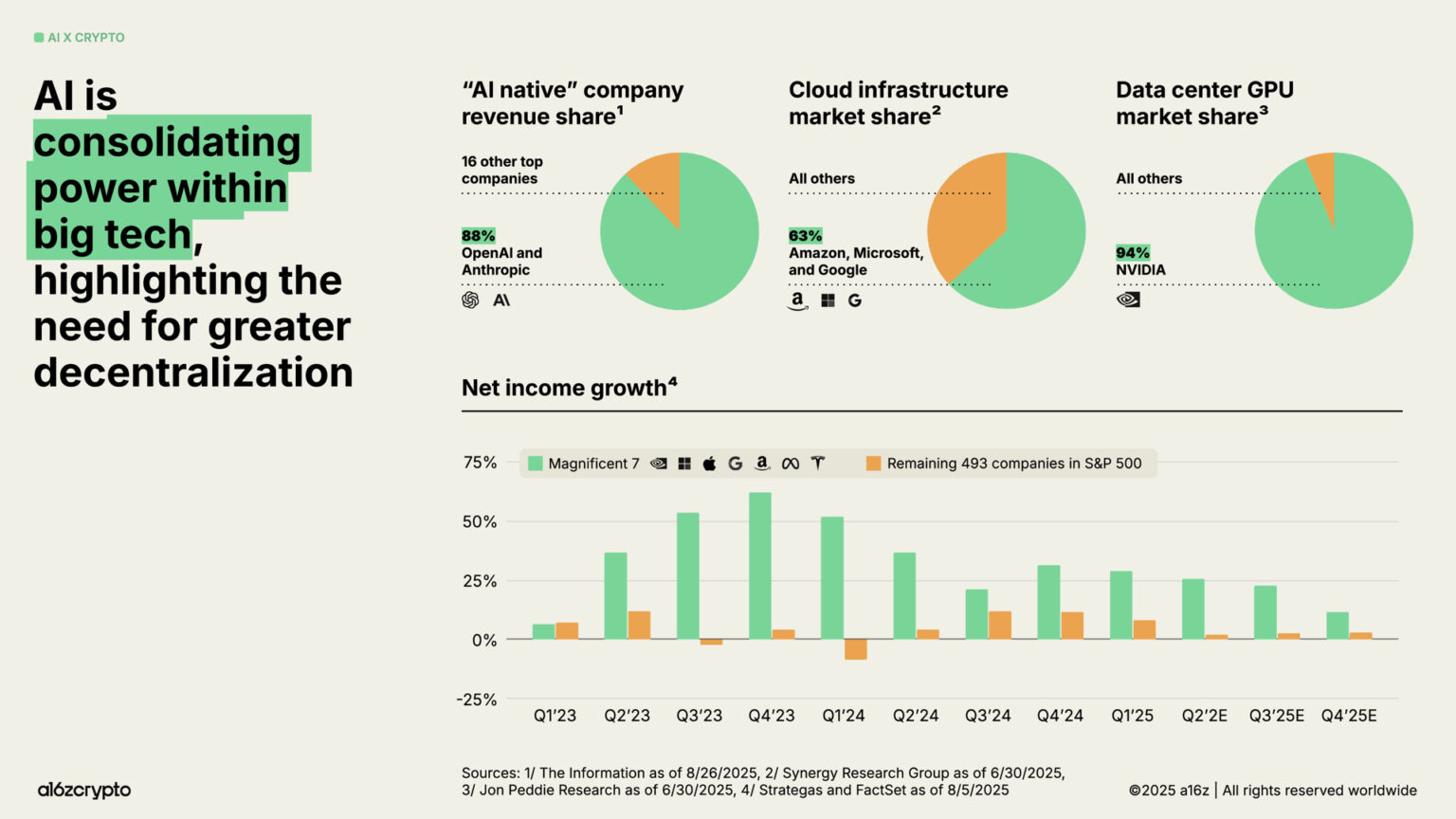
In the AI boom, some builders are turning to the AI field. Our analysis shows that since the release of ChatGPT, about 1,000 positions have shifted from the crypto space to AI; however, this change has been almost completely offset by new entrants from traditional finance and tech industries, meaning a significant number of builders are joining the cryptocurrency sector.
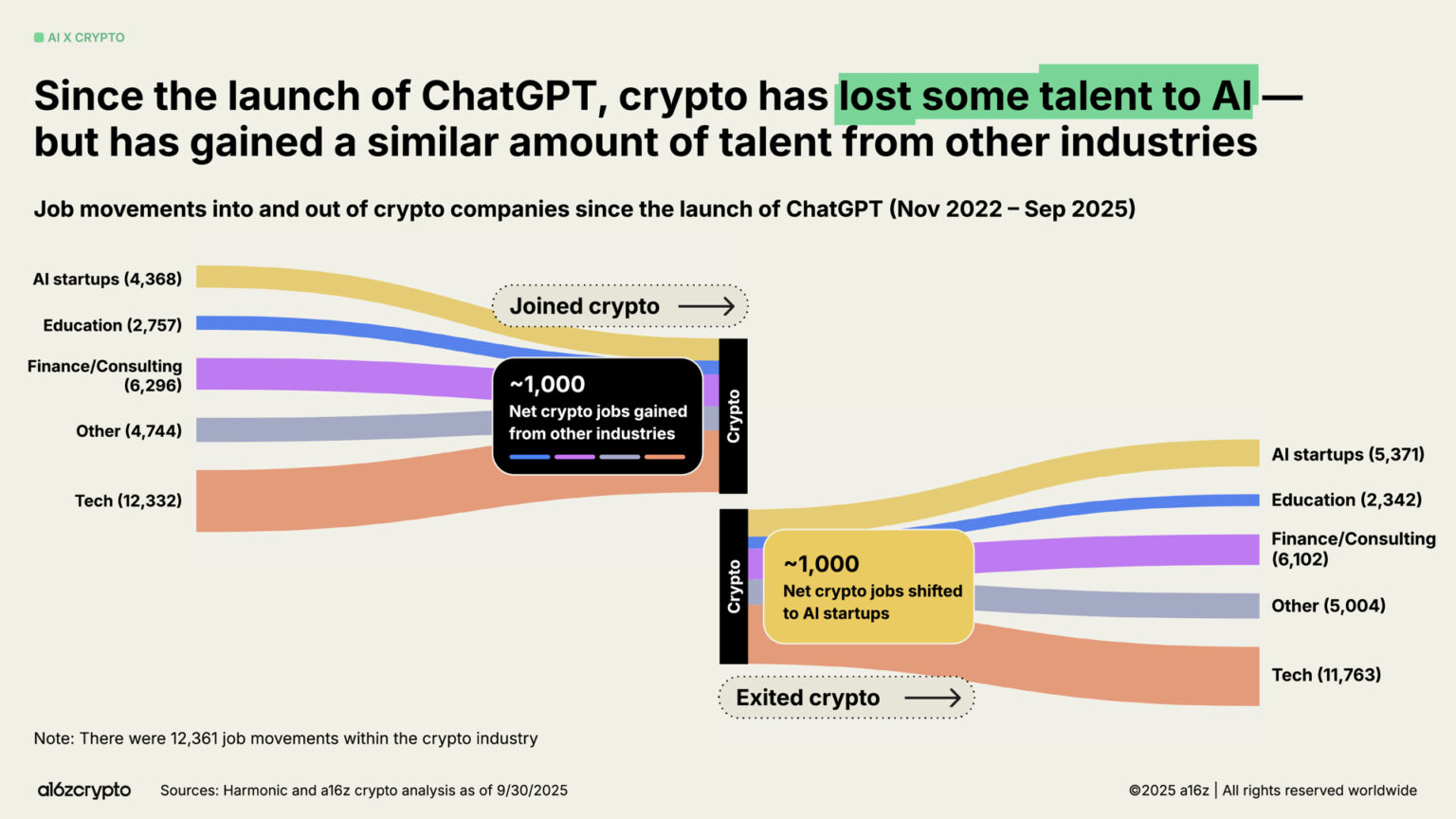
What’s Next?
So, where do we stand now?
As the regulatory environment becomes clearer, "tokens" are gradually finding a viable path to generate real revenue through transaction fees. The adoption of crypto by traditional finance and fintech will continue to accelerate; stablecoins will upgrade existing financial systems and provide inclusive financial services globally; and a new generation of consumer-grade products will bring the next wave of on-chain users.
We now have a robust infrastructure and distribution channels, and we expect to gain a clearer regulatory framework in the near future to drive this technology toward mainstream adoption. Now is the time to upgrade the global financial system, reshape payment networks, and build the internet that the world truly deserves.
After seventeen years, the cryptocurrency industry is bidding farewell to its adolescent phase and entering a stage of mature development.
免责声明:本文章仅代表作者个人观点,不代表本平台的立场和观点。本文章仅供信息分享,不构成对任何人的任何投资建议。用户与作者之间的任何争议,与本平台无关。如网页中刊载的文章或图片涉及侵权,请提供相关的权利证明和身份证明发送邮件到support@aicoin.com,本平台相关工作人员将会进行核查。
